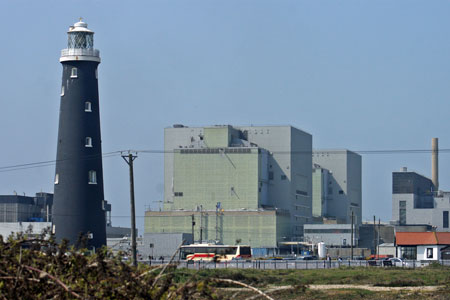|
|
|
| |
This page is under
construction
|
|
|
This page is one of a series devoted to postcards and
photographs of British lighthouses. This page covers the counties of Essex &
Kent. In addition to the major lighthouses, the page shows other
navigational lights and beacons where possible.
|
|
|
|
|
|
All images link to larger
copies which will open in a new window/tab
This page is one of a series devoted to postcards and
photographs of British lighthouses. This page covers the counties of Essex &
Kent
.
The two lighthouses at Harwich were built in 1865 to
guide ships towards the River Stour. The High Light was in the centre of the
town, with the Low Light on what is now the promenade. The lights were not
under the supervision of Trinity House and were generally considered to have
been inadequate. Not until 1818 were improvements made, when the existing
structures were built, realigned nine feet to the south-west. The High Light
was shown 40ft below the top (the section above acing as a land mark) but
this proved to be too low. It was moved further up in 1822, and its
illumination increased. Both lights were taken over by Trinity House in
1837, but were replaced in 1863 by the new lights at Dovercourt, necessary
because of the increased size of the spit at Landguard Point. The lights
were sold to Harwich Council in 1909, and had to be available for use as
lights again if the channel moved again. Both are now museums and are open
to the public at certain times.
Harwich Low Light
Photo: © Ian Boyle, 9th December 2006

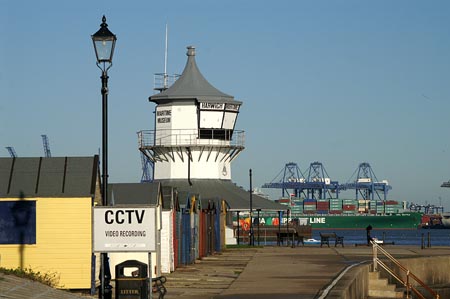
Harwich High Light
Photo: © Ian Boyle, 9th December 2006
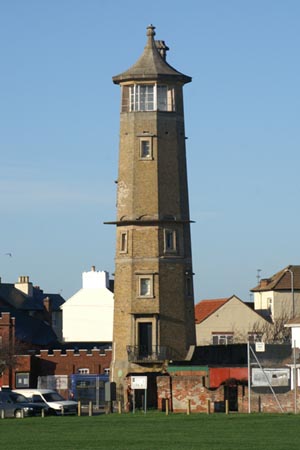
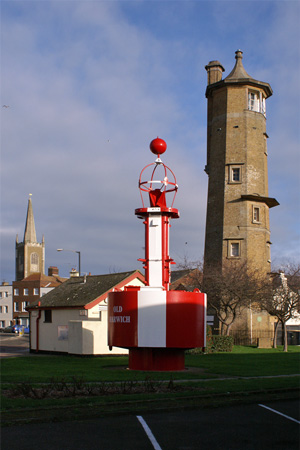
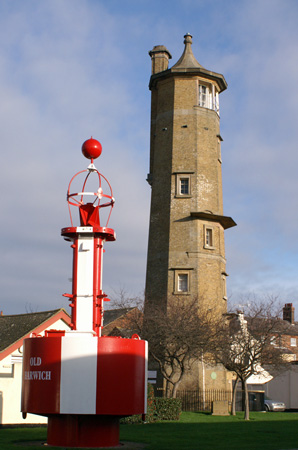
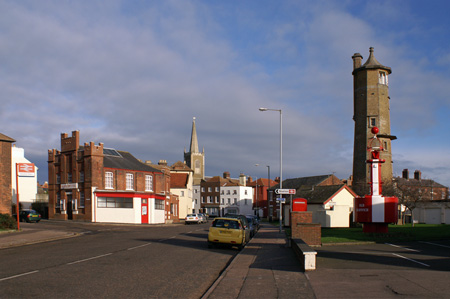
Harwich High Light seen from the
sea
Photo: © Ian Boyle, 8th May 2008
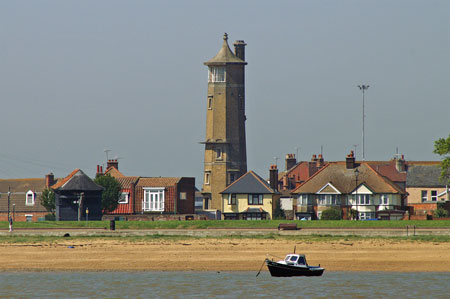
The High and Low Lights at Dovercourt were built
between 1862 and 1863 to replace the lights at Harwich which had become
ineffective. They were discontinued in 1917, and were sold in 1922 to
Harwich Town Council on the understanding that they would be dismantled if
they became unsafe. Now listed historic structures, they were restored in
the 1980s by the High Stewards Lighthouse Appeal.
Postcard showing Dovercourt High
and Low lights
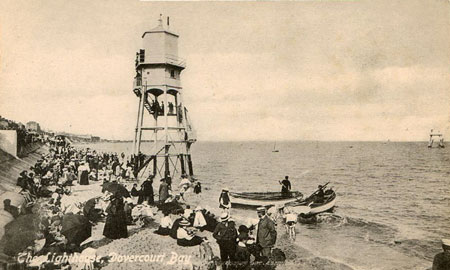
Postcard showing Dovercourt High
and Low lights in the distance
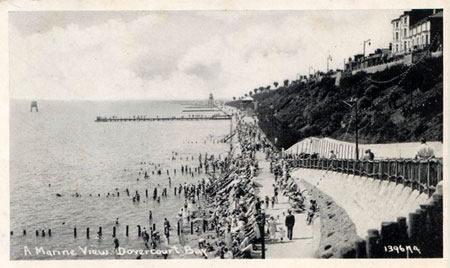
Postcard showing Dovercourt High
and Low lights
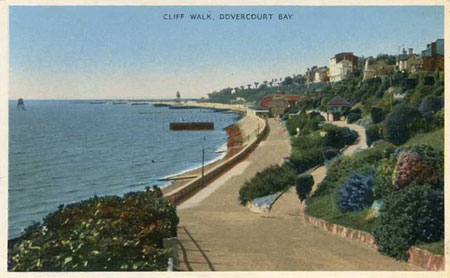
Postcard showing Dovercourt High
and Low lights, posted 1964
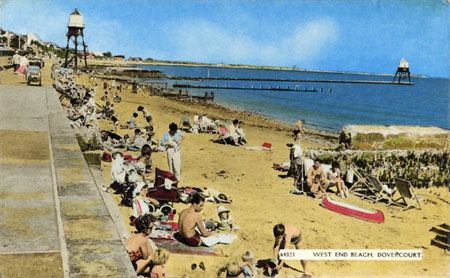
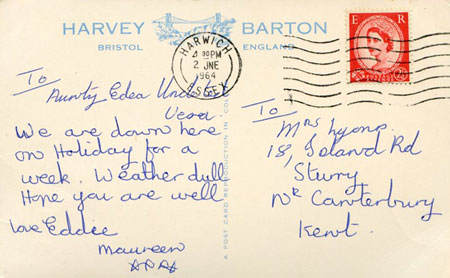
Postcard showing Dovercourt High and Low Lights
Photo: © Ian Boyle, 9th December 2006
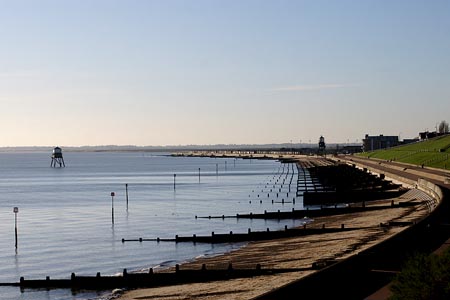
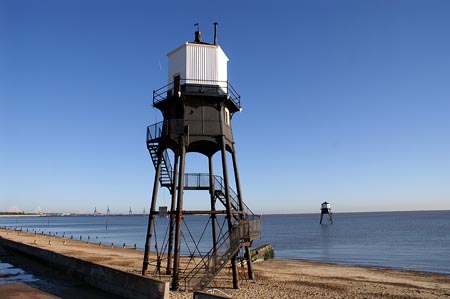
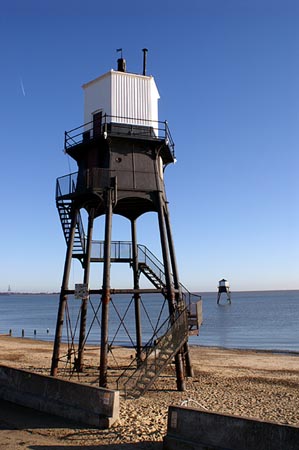
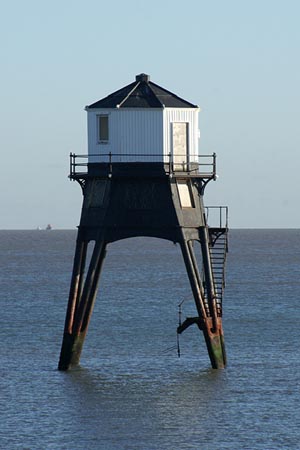
Dovercourt High and Low Lights,
showing the causeway between the two at low tide
Photo: © Ian Boyle, 25th February 2007
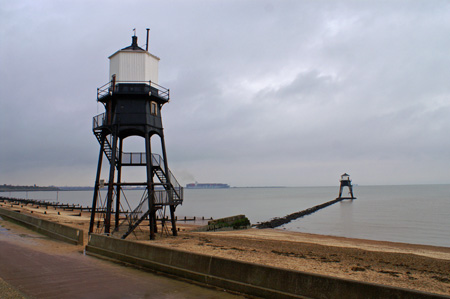
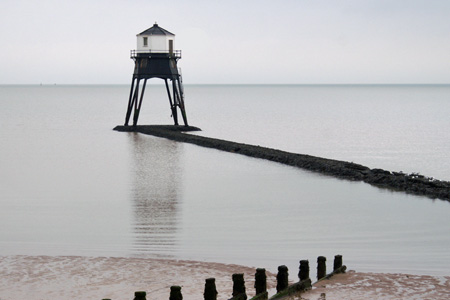
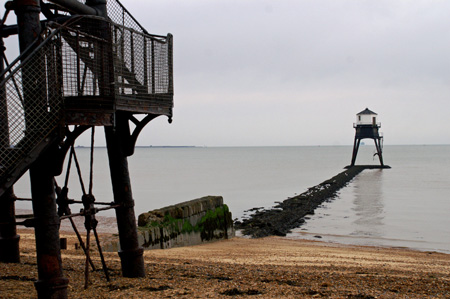
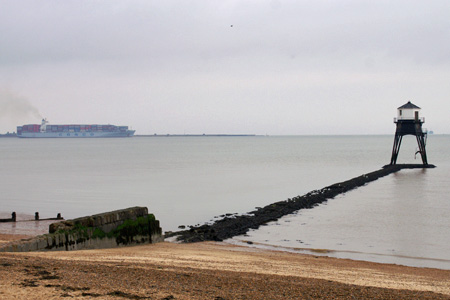
The Naze Tower was built by Trinity House in 1720,
although there is some doubt about how long, if at all, it carried a light.
It is an octagonal red brick construction, originally between 86-90ft tall.
The top was rebuilt in the 19th century. It was restored in 2004 and is open
to visitors during the summer months.
Website:
www.nazetower.co.uk
Email:
mail@nazetower.co.uk
Naze Tower
Photo: © Ian Boyle, 7th October 2006
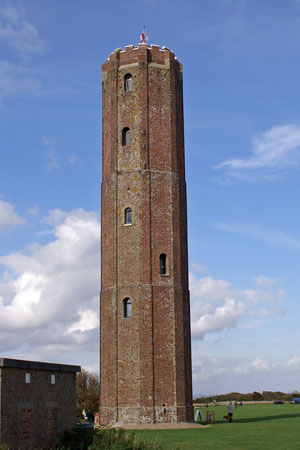
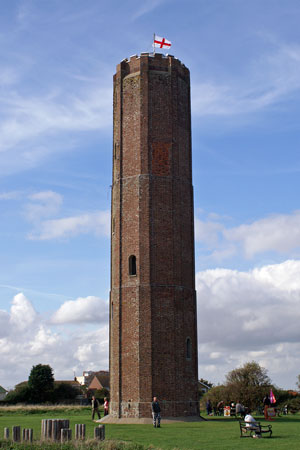
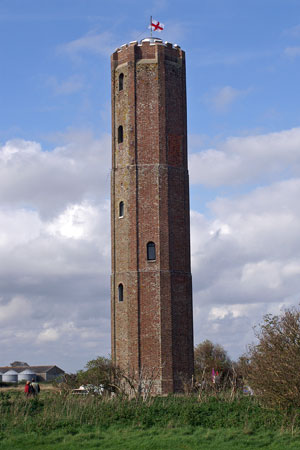
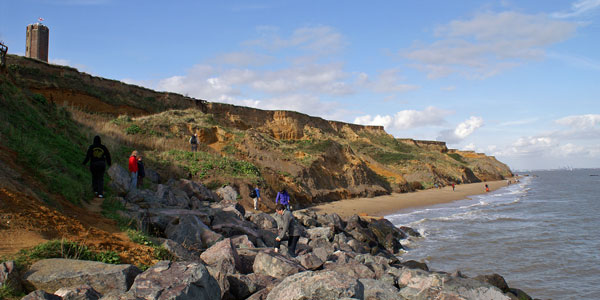
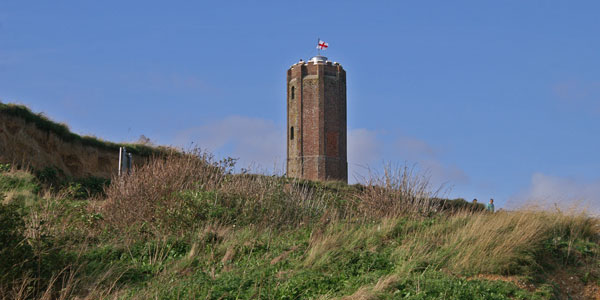
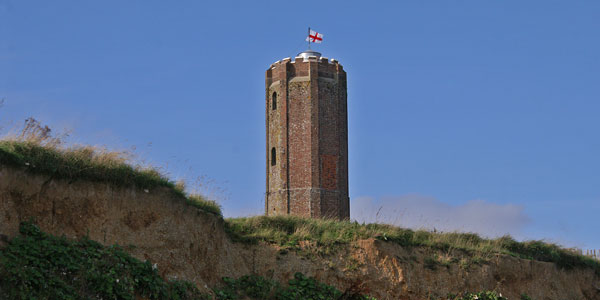
Naze Tower seen from Walton Pier
Photo: © Ian Boyle, 7th October 2006
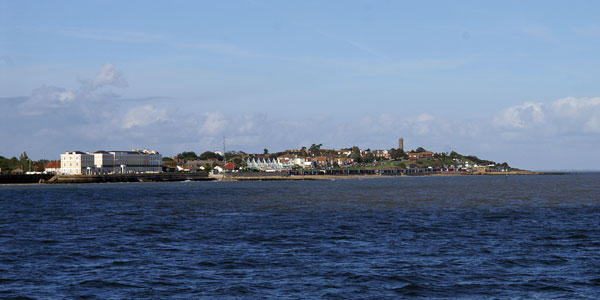
Naze Tower seen from MV
Balmoral
Photo: © Ian Boyle, 26th June 2007
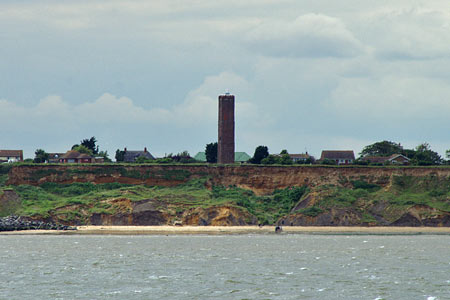
Gunfleet lighthouse is a screw pile structure with
six outer and one central piles, similar in design to the light at
Chapman shown below. The light was
decommissioned in 1920, but was subsequently refitted as a pirate radio
station. The structure was in territorial waters so could be shut down
before broadcasts started. It was used as a meteorological station in 2002
prior to the building of the Gunfleet wind farm which started in 2009.
Gunfleet Wind Farm - with the
lighthouse just visible on the horizon to the left
Photo: © Ian Boyle, 29th July 2010
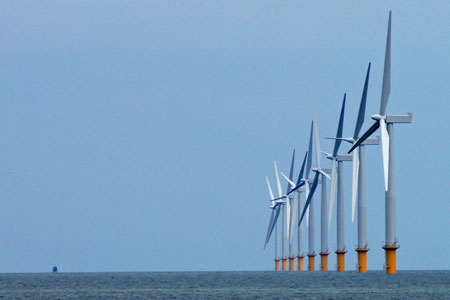
Gunfleet Wind Farm - with the
lighthouse just visible on the horizon to the left
Photo: © Ian Boyle, 29th July 2010
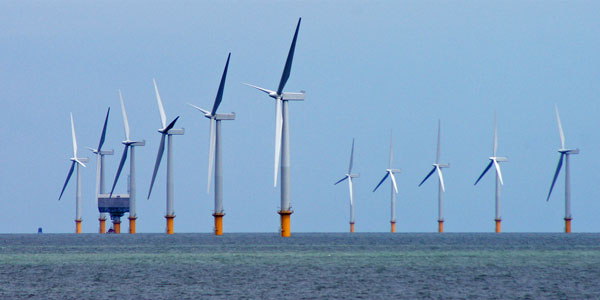
Chapman Sands off Canvey Island had a screw pile
lighthouse erected in 1849. In 1950s it was undermined by the sea and it was
replaced by a buoy in 1958.
Postcard of Chapman Sands
lighthouse off Canvey
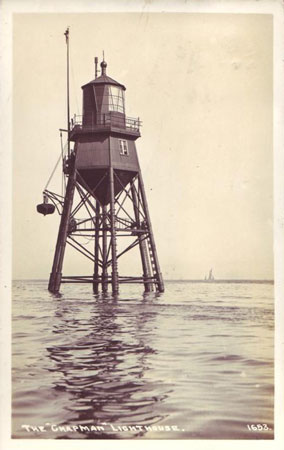
Postcard of the General Steam
Navigation's Crested Eagle passing Chapman Sands
lighthouse off Canvey
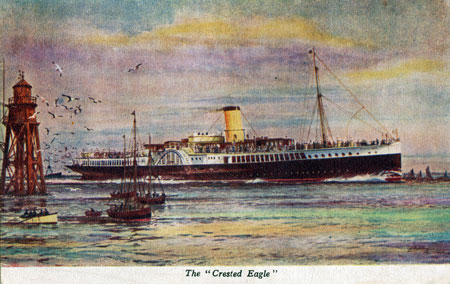
Postcard of the General Steam
Navigation's Crested Eagle passing Chapman Sands
lighthouse off Canvey
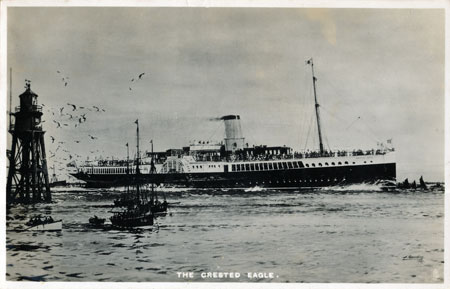
This section shows some of the minor lights along the
Thames between Gravesend/Tilbury and the City. There are nine land-based
unattended lights on the Thames, originally erected by Trinity House. They
are now maintained by the Port of London Authority (PLA). Whilst not
lighthouses as such, they are included for completeness. I have not yet
photographed them all.
Broadness light is on the bend between St Clement's
Reach and Northfleet Hope. It is 43ft high and was built in 1975, replacing
a structure from 1885.
Broadness light
Photo: © Ian Boyle, 14th June 2006
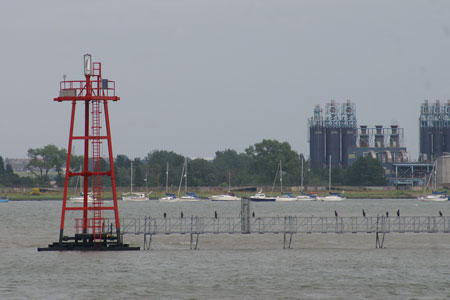
Stoneness light is placed in the north bank where the
river bends into Long Reach, close to the M25 Dartford River Crossing. It
was built in 1885 and is 42ft tall. It is powered by a wind generator.
Stoneness light being passed by
Adsteam Laceby, running in reverse, as tugs tend to do on the
Thames to reduce wash
Photo: © Ian Boyle, 7th October 2006
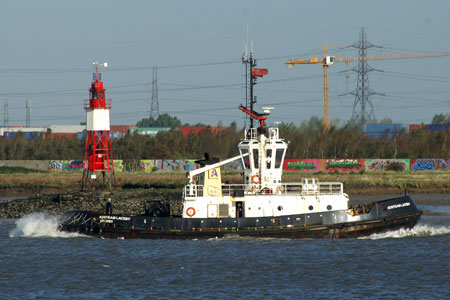
Stoneness light being passed by
Friston Down
Photo: © Ian Boyle, 7th October 2006
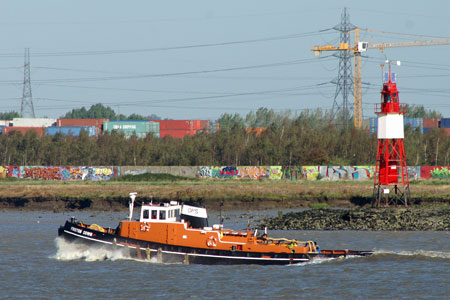
General Steam Navigation poster
card showing a stylised image of Stoneness light being passed by Royal
Eagle
Photo: © Ian Boyle, 7th October 2006
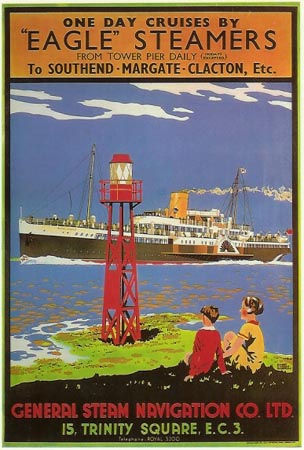
Tripcock Ness light is placed on the south bank at
the eastern end of Gallions Reach. It is 30ft high and was built in 1902.
Tripcock Ness light
Photo: © Ian Boyle, 14th June 2006
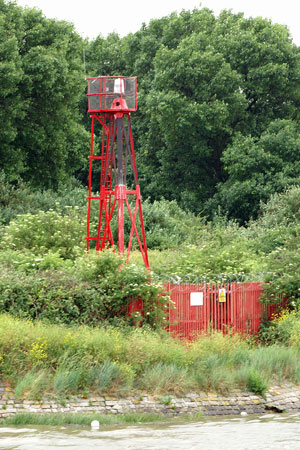
Coldharbour Point light marks the bend between Erith
Roads and Erith Reach. It is located on the north bank of the Thames by
Rainham Marshes. It was built in 1885 and can be reached via a footpath
alongside the Rainham landfill site.
Coldharbour Point light
Photo: © Ian Boyle, 7th May 2011
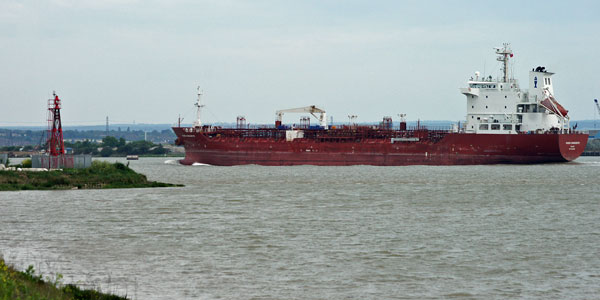
Coldharbour Point light
Photo: © Ian Boyle, 7th May 2011
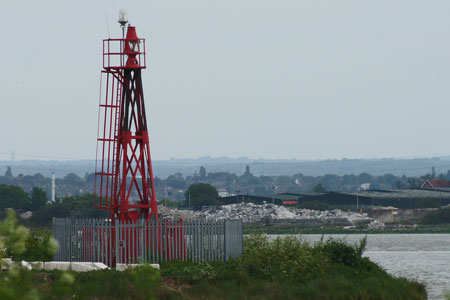
Coldharbour Point light
Photo: © Ian Boyle, 7th May 2011
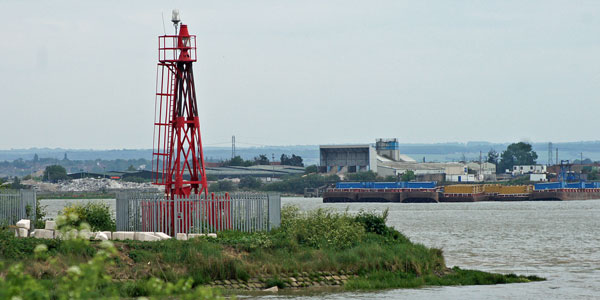
Coldharbour Point light
Photo: © Ian Boyle, 7th May 2011
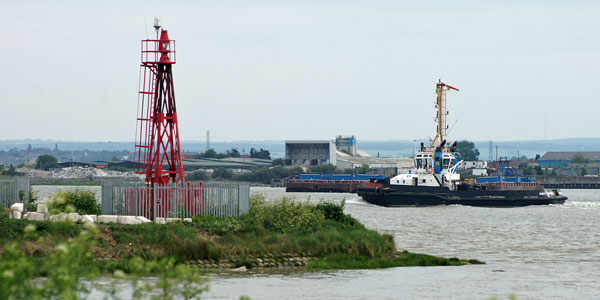
Coldharbour Point light
Photo: © Ian Boyle, 7th May 2011
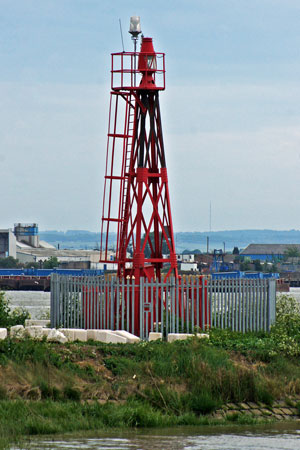
Coldharbour Point light
Photo: © Ian Boyle, 7th May 2011
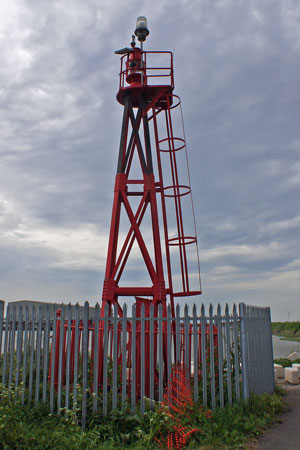
Coldharbour Point light
Photo: © Ian Boyle, 7th May 2011
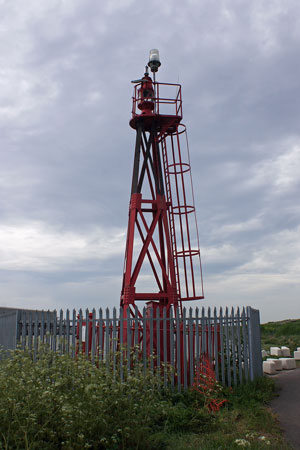
Cross Ness light is placed on the south bank at the
eastern end of Barking Reach. It is 41ft high and was built in 1895.
Cross Ness light
Photo: © Ian Boyle, 14th June 2006
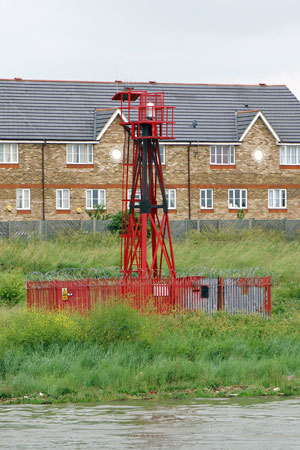
Trinity House set up a depot at Blackwall in 1804.
They repaired lightships there and upgraded the quays to form Trinity Buoy
Wharf in 1822. Experiments were carried there on electric lights by Michael
Faraday from 1836. In 1854 an experimental lighthouse was constructed to
test the electric lights. A second light was built in 1864 to train
lighthouse keepers, and this is the light which survives. Neither light was
ever used for navigational purposes. The light is located opposite the o2
Dome. Thames Clippers moved their base to Trinity Buoy Wharf late 2007,
which obstructs images of the lighthouse from the river.
Blackwall training lighthouse
Photo: © Ian Boyle, 26th September 2006
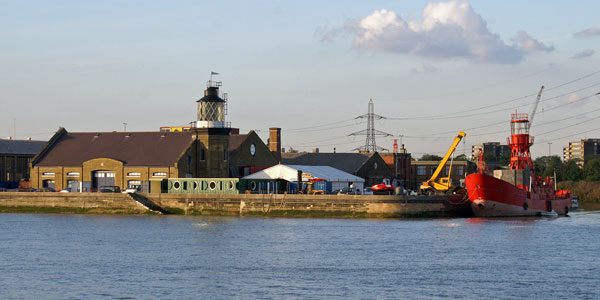
Blackwall training lighthouse
Photo: © Ian Boyle, 26th September 2006
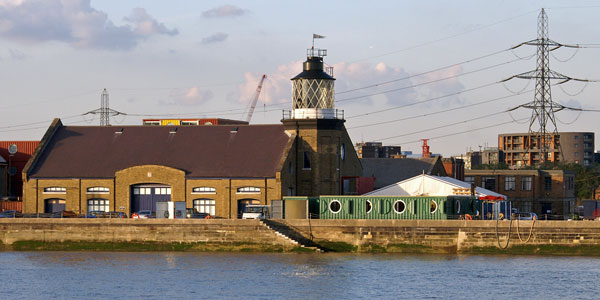
Blackwall training lighthouse
Photo: © Ian Boyle, 26th September 2006
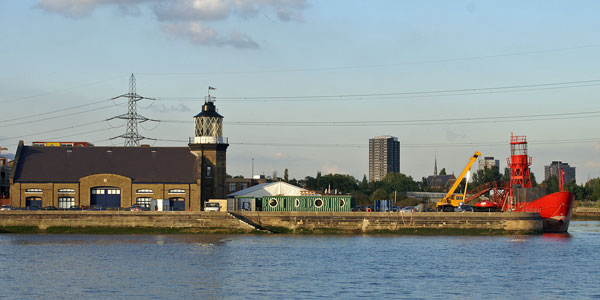
Blackwall training lighthouse
Photo: © Ian Boyle, 23rd May 2007
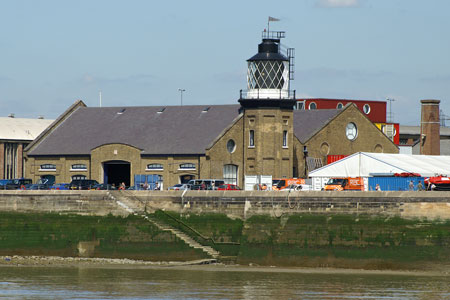
Blackwall training lighthouse
Photo: © Ian Boyle, 23rd May 2007
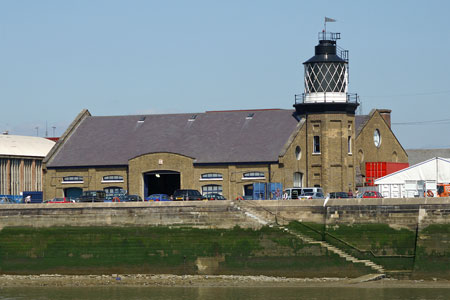
Blackwall training lighthouse
Photo: © Ian Boyle, 23rd May 2007
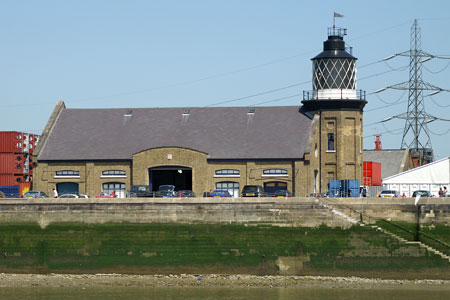
Blackwall training lighthouse
Photo: © Ian Boyle, 4th October 2007
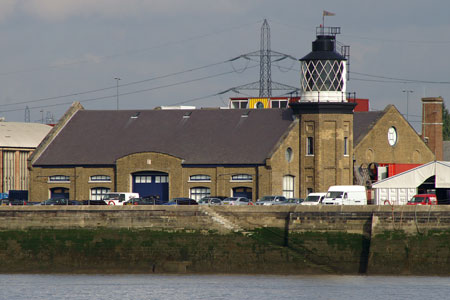
Blackwall training lighthouse,
after the Thames Clippers jetty had been built
Photo: © Ian Boyle, 4th October 2009

Two of the four Gravesend piers had navigation lights
mounted in small towers, the Town Pier and the Royal Terrace Pier.
Gravesend Town Pier, showing
navigation light
Photo: © Ian Boyle, 9th June 2008
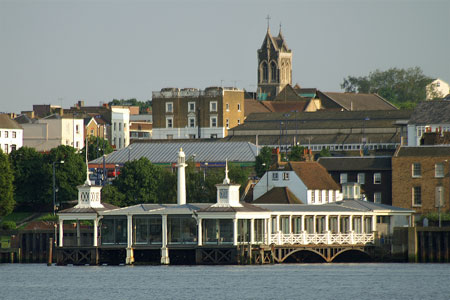
Gravesend Town Pier, showing
navigation light
Photo: © Ian Boyle, 24th June 2008
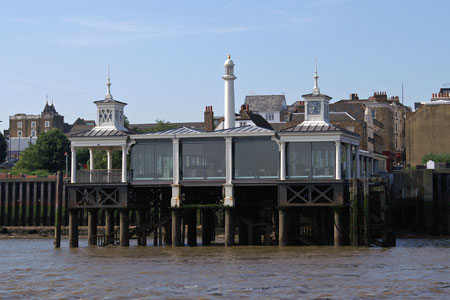
Gravesend Royal Terrace Pier,
showing navigation light
Photo: © Ian Boyle, 9th June 2008
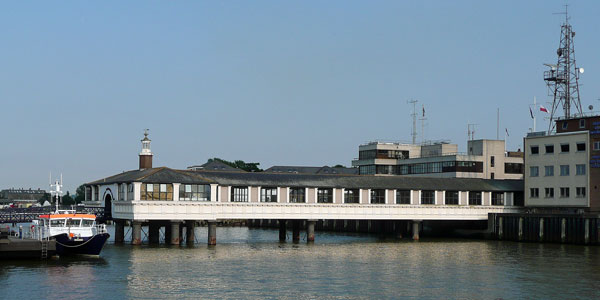
Gravesend Royal Terrace Pier,
showing navigation light
Photo: © Ian Boyle, 9th June 2008

Margate stone pier was built in 1828 and 100ft
lighthouse was added at the end in 1829. It was destroyed in the great storm
of 31st January 1958, and was replaced by a 66ft tower in 1954.
Margate
Photo: © Ian Boyle, 10th July 2006
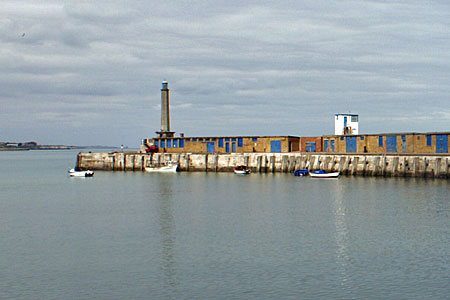
Margate
Photo: © Ian Boyle, 25th September 2007
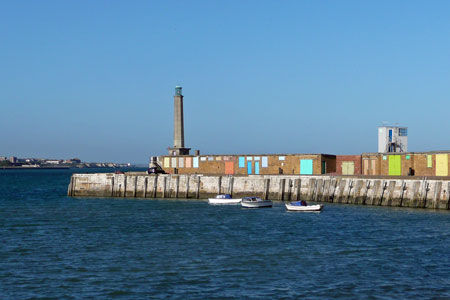
Margate
Photo: © Ian Boyle, 25th September 2007
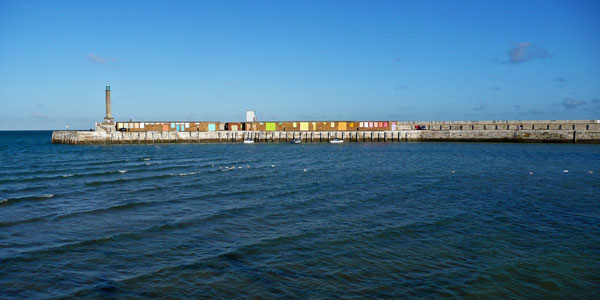
Margate
Photo: © Ian Boyle, 25th September 2007
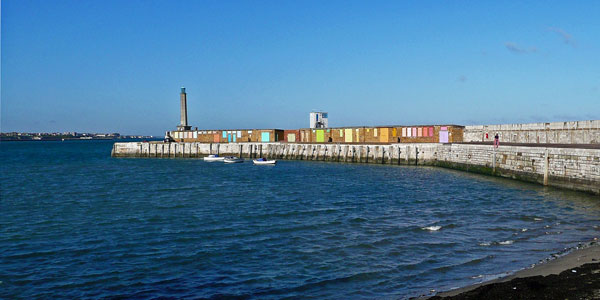
Margate Pier Lighthouse
Photo: © Ian Boyle, 30th April 2011
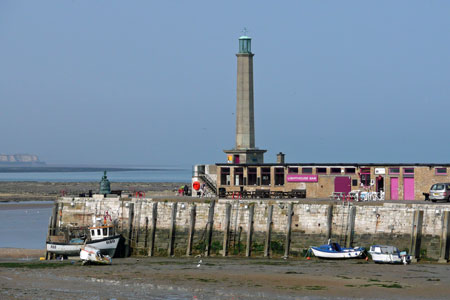
Margate Pier Lighthouse
Photo: © Ian Boyle, 30th April 2011

Margate Pier Lighthouse
Photo: © Ian Boyle, 30th April 2011
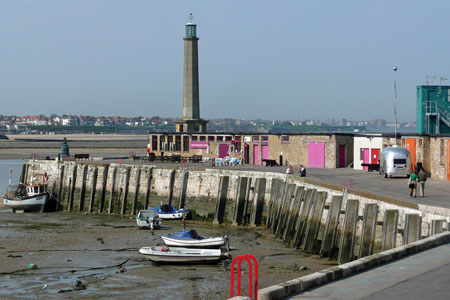
Margate Pier Lighthouse
Photo: © Ian Boyle, 30th April 2011
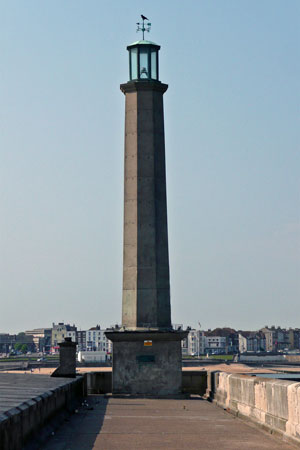
Margate Pier Lighthouse
Photo: © Ian Boyle, 30th April 2011
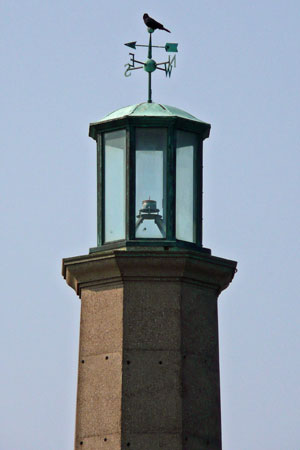
Margate Pier Lighthouse
Photo: © Ian Boyle, 30th April 2011
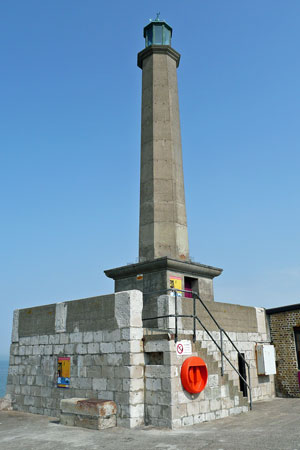
Margate Pier Lighthouse
Photo: © Ian Boyle, 30th April 2011
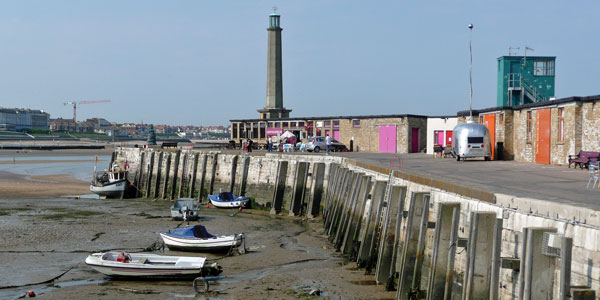
North Foreland lighthouse stands on the outskirts of
Broadstairs, and it was one of the first to be managed by Trinity House.
Lights on wooden towers were positioned at both North and South Foreland in
1637 under patent from Charles I. The tower at North Foreland burnt down in
1683 and new flint and brick tower was built in 1691. In 1719 both lights
passed to the Greenwich Royal Naval Hospital and the brick foundations of
the North Light were extended. It was increased in height again in 1793, to
take its current form. It was modernised and painted white in 1866. North
Foreland was automated in 1998.
Postcard of North Foreland Lighthouse
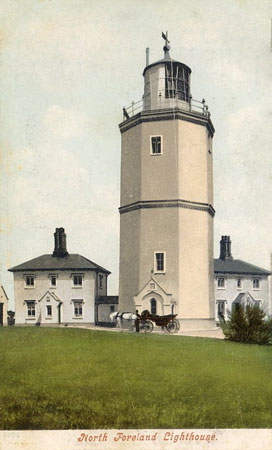
Postcard of North Foreland Lighthouse
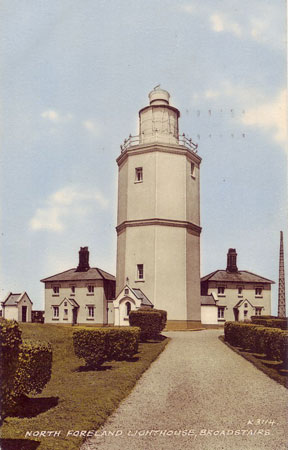
Postcard of North Foreland Lighthouse
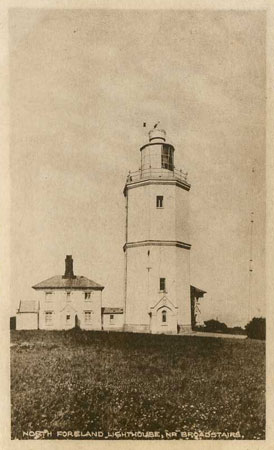
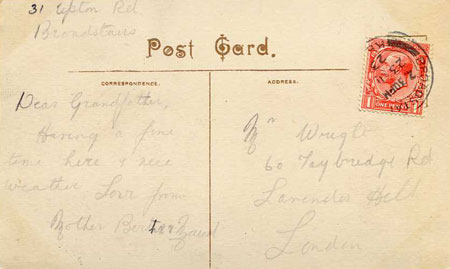
Postcard of North Foreland Lighthouse
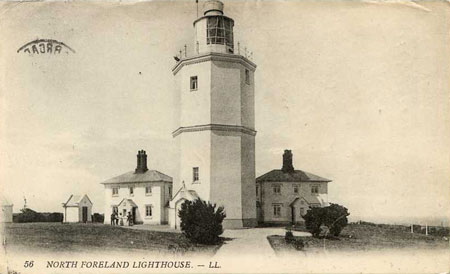

Postcard of North Foreland Lighthouse
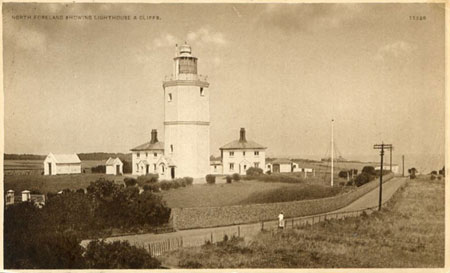
Postcard of North Foreland Lighthouse
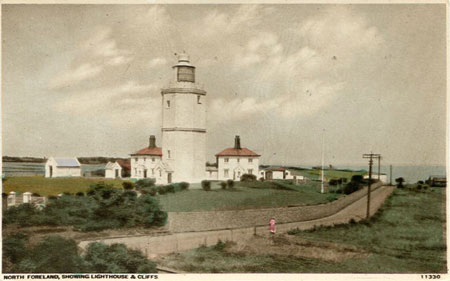
Postcard of North Foreland Lighthouse
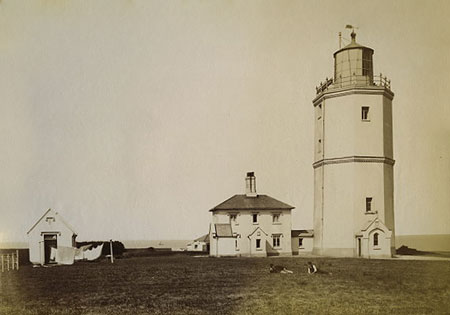
Postcard of North Foreland Lighthouse
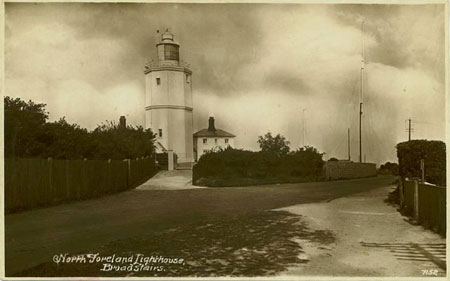
Postcard of North Foreland Lighthouse
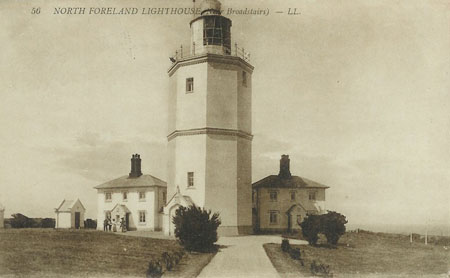
North Foreland Lighthouse - seen
from MV Balmoral
Photo: © Ian Boyle, 12th November 2006
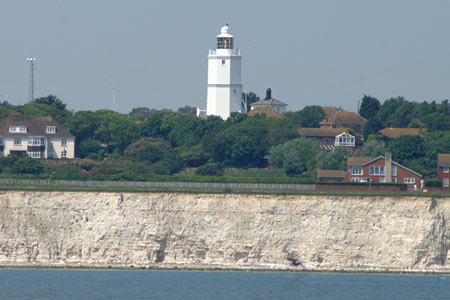
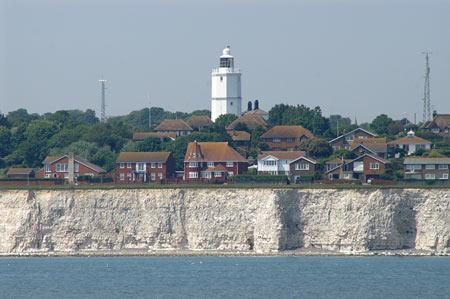
North Foreland Lighthouse - seen
from the road
Photo: © Ian Boyle, 10th July 2007
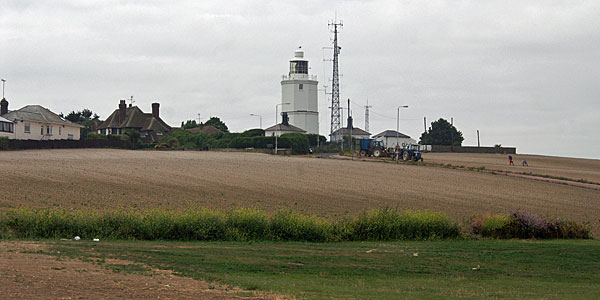
North Foreland Lighthouse
Photo: © Ian Boyle, 16th March 2012
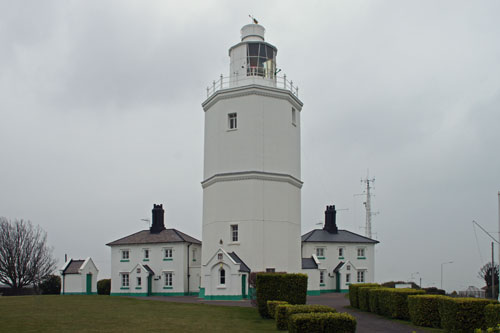
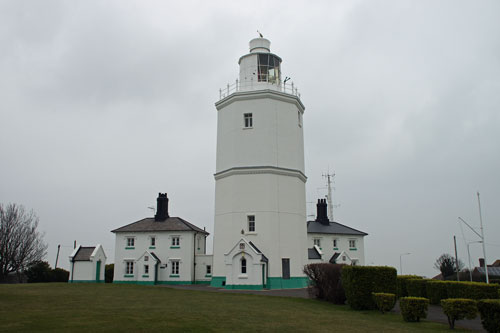
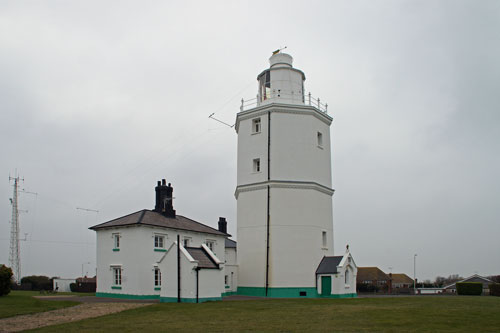
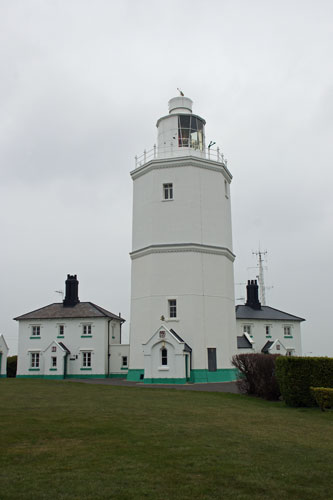
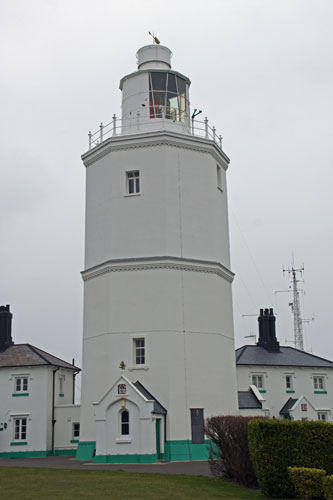
North Foreland Lighthouse
Photo: © Ian Boyle, 21st March 2012
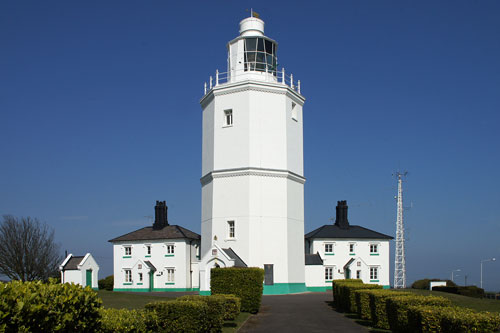
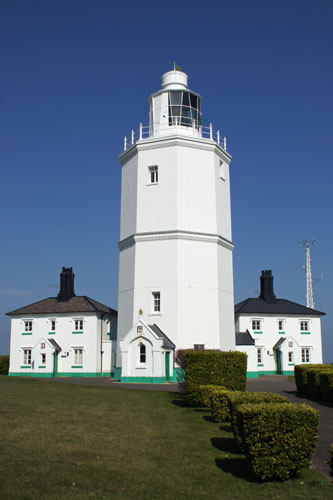
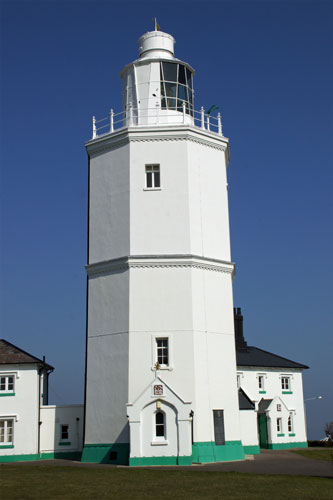
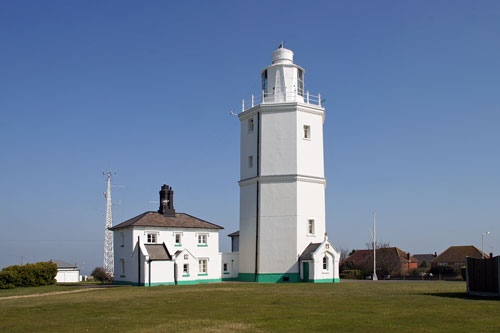
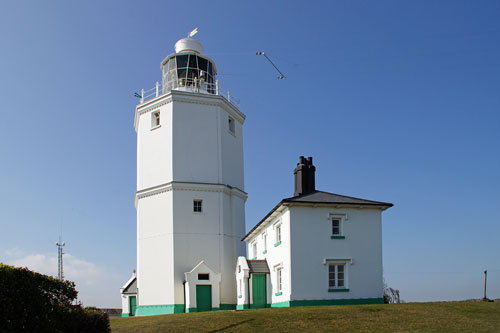
Work on creating Ramsgate harbour began in 1749, and
the East and West were finished in 1779. A lighthouse was completed at the
end of the West Pier in 1795. This was replaced in 1842 with the current
tower. Two rock breakwaters have been added to the harbour more recently,
each of which have small lights.
Old Postcards of Ramsgate lighthouse
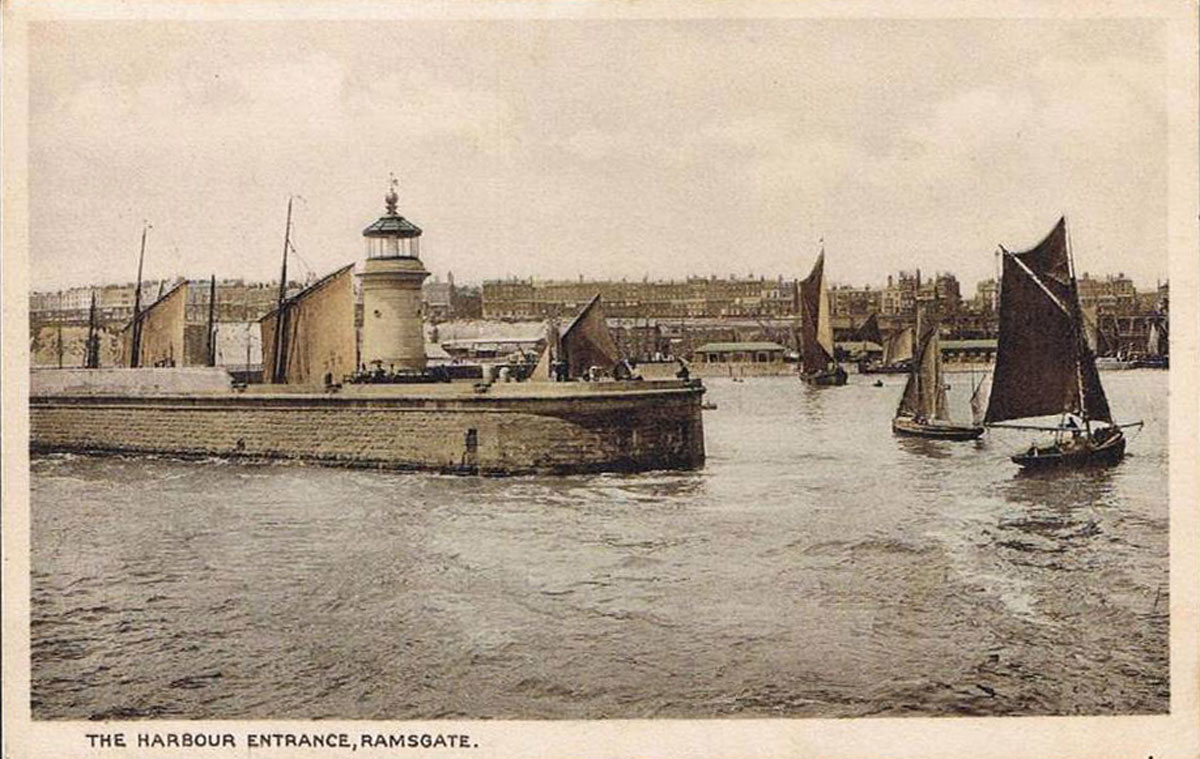
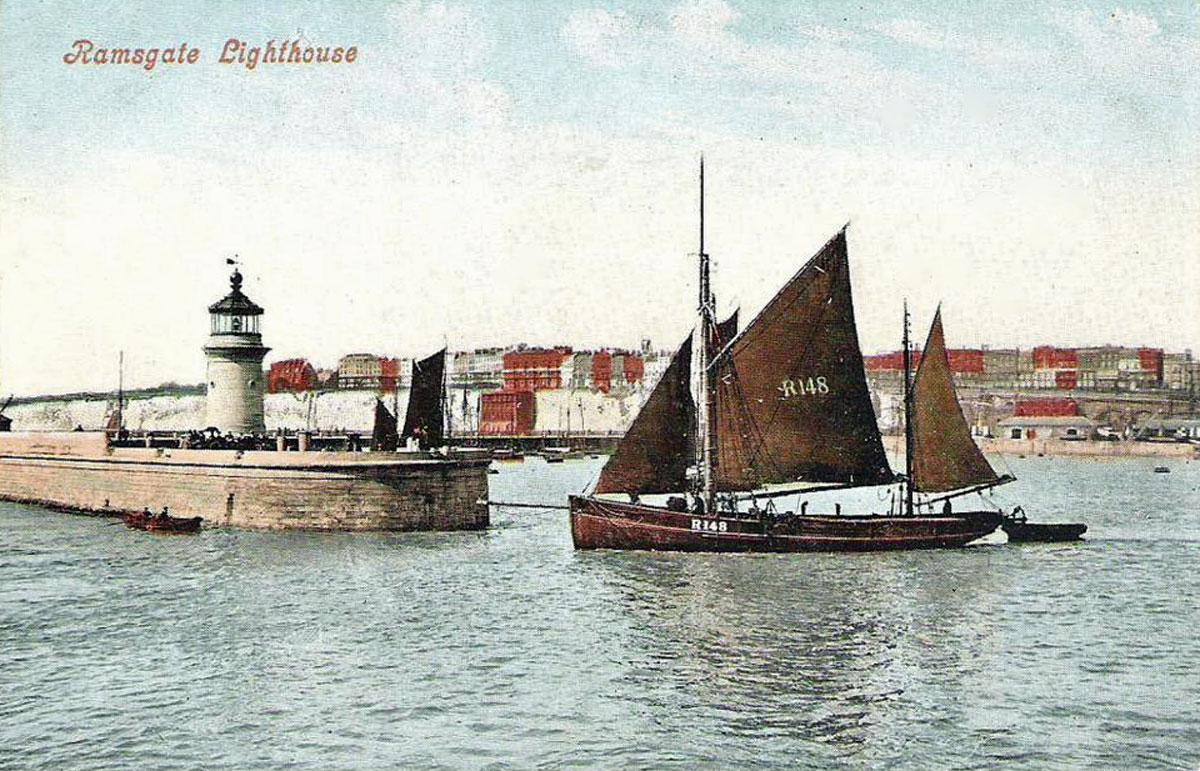
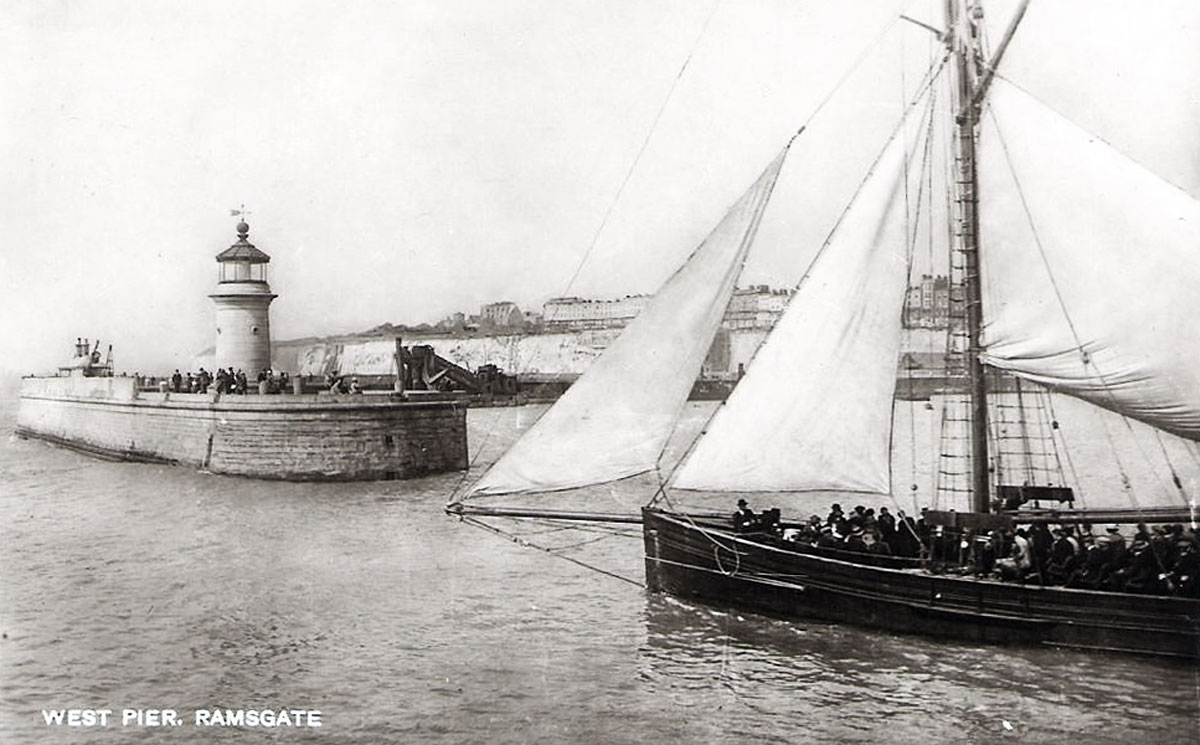
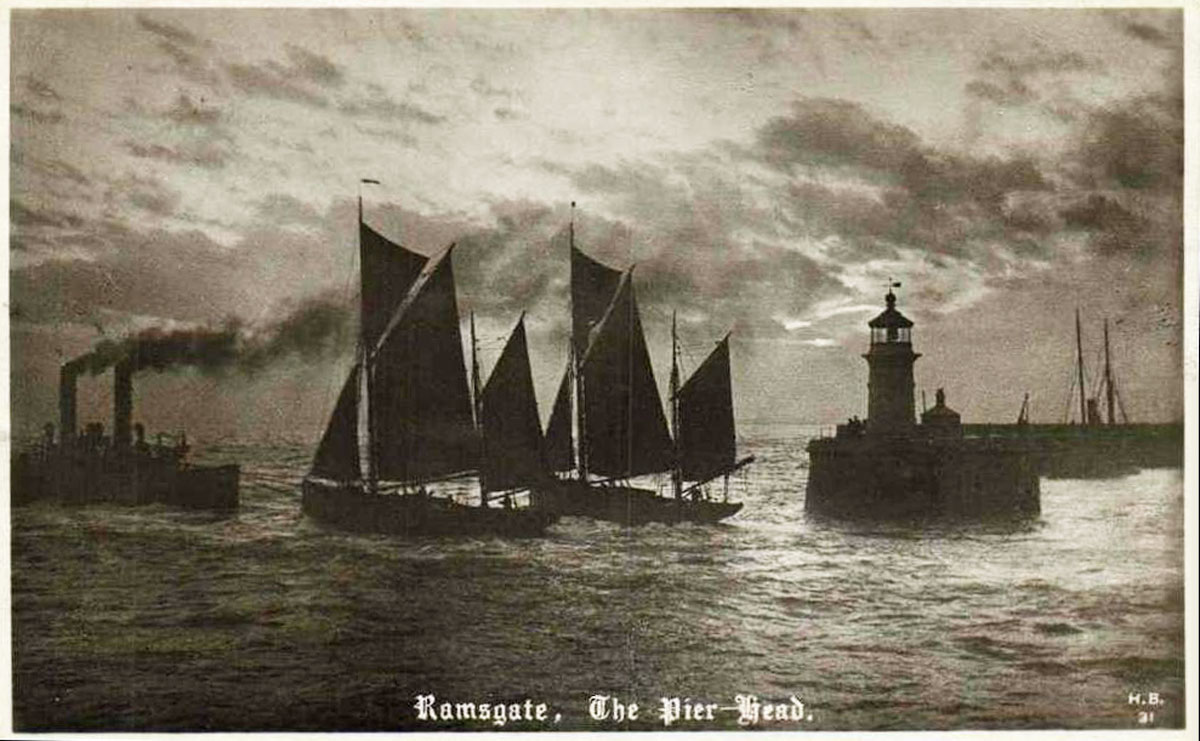
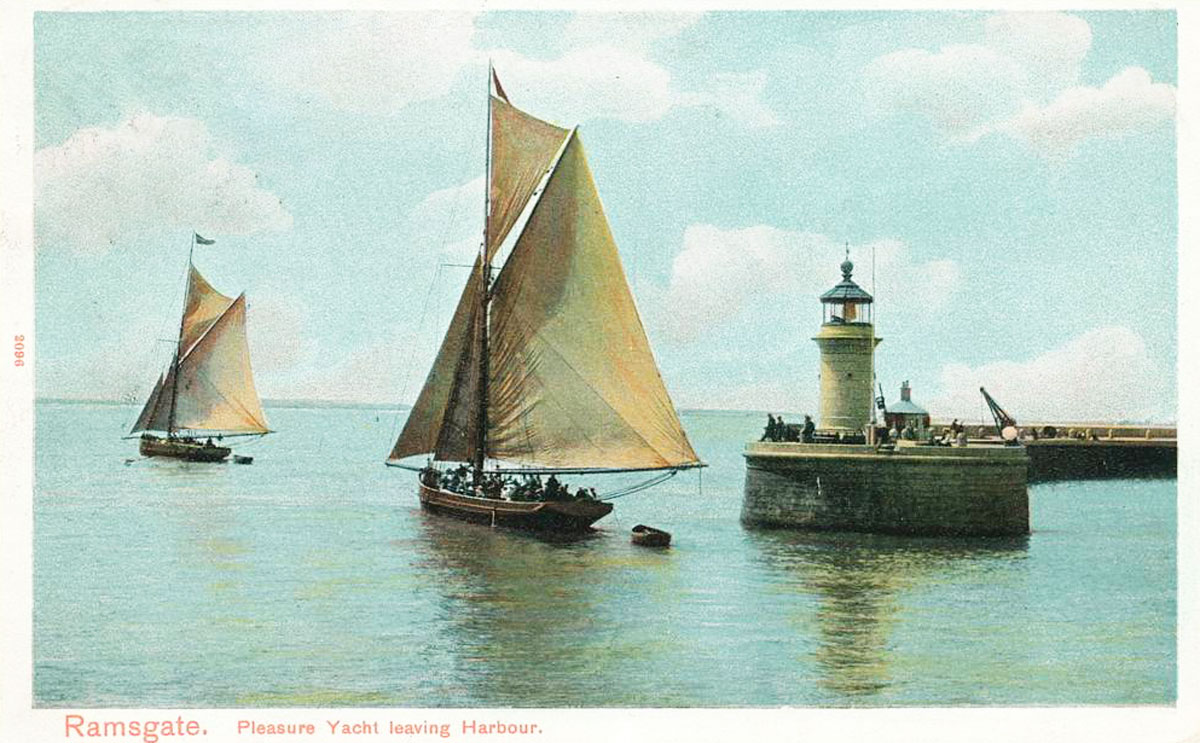
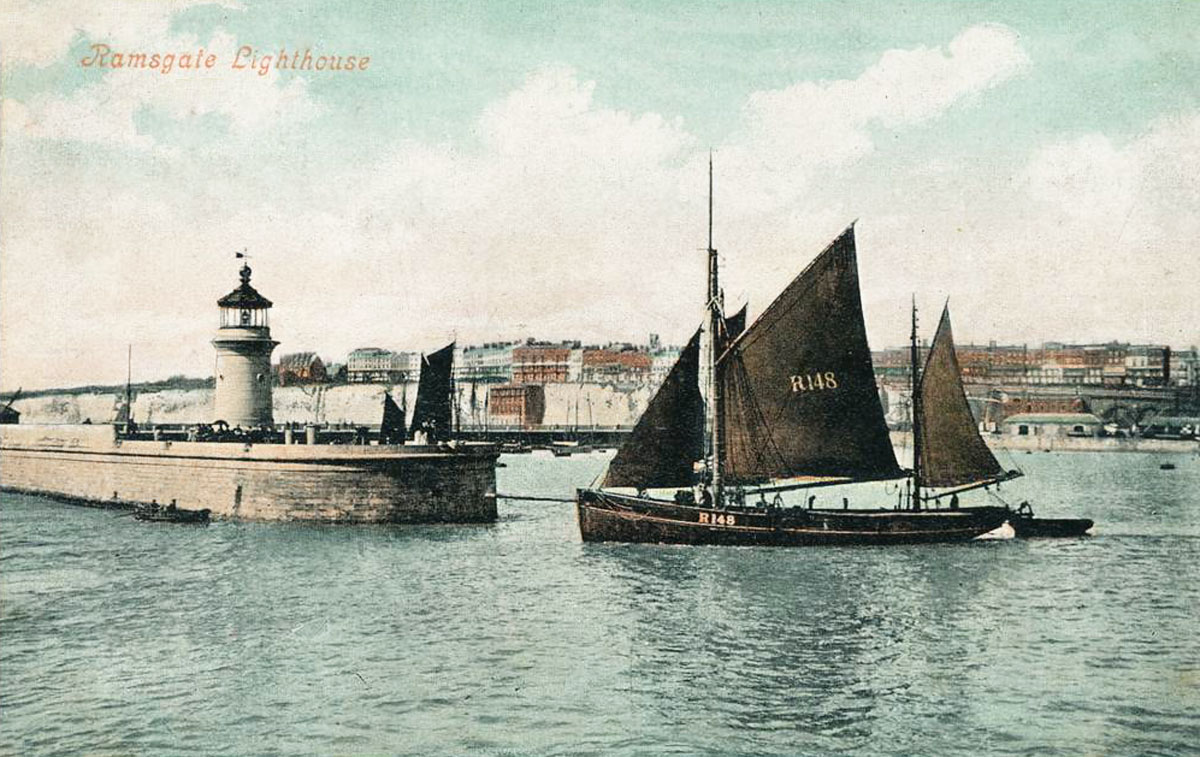
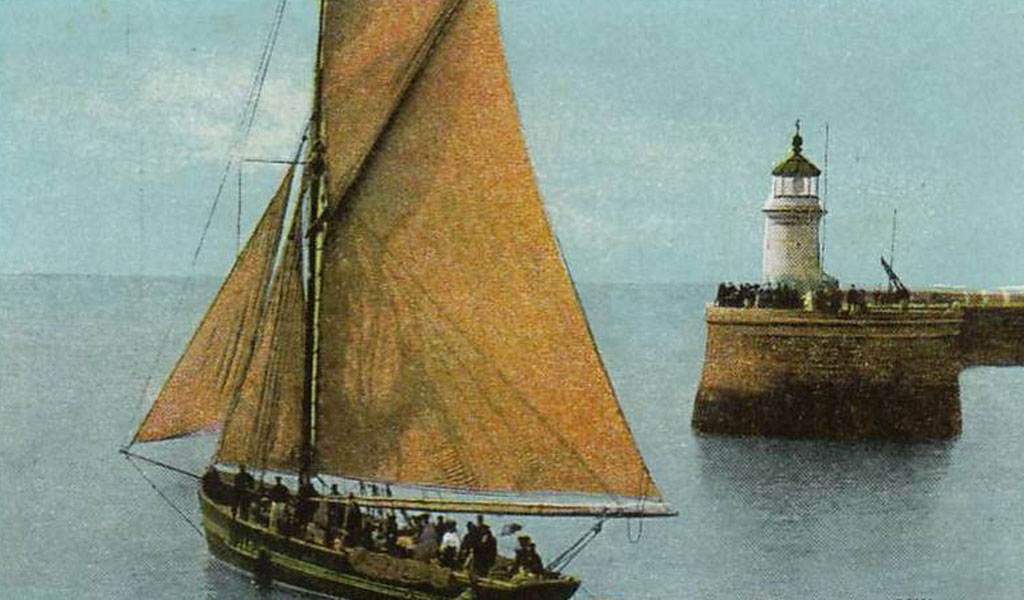
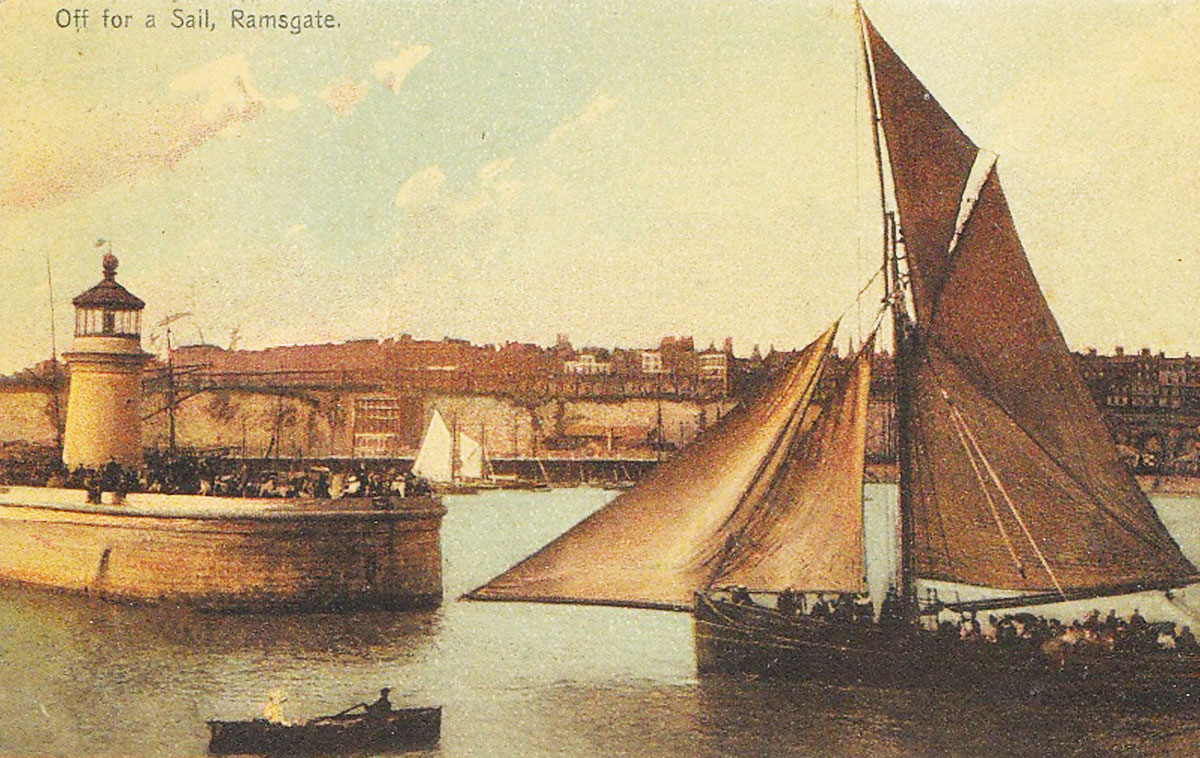
Images of Ramsgate lighthouse
Photos:- ©2010 Ian Boyle
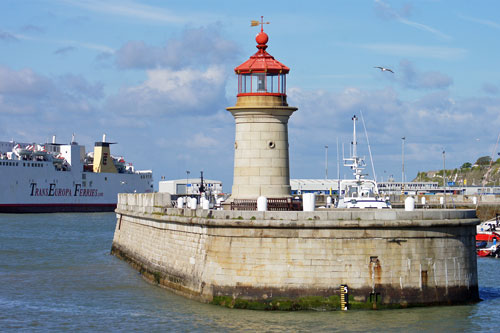
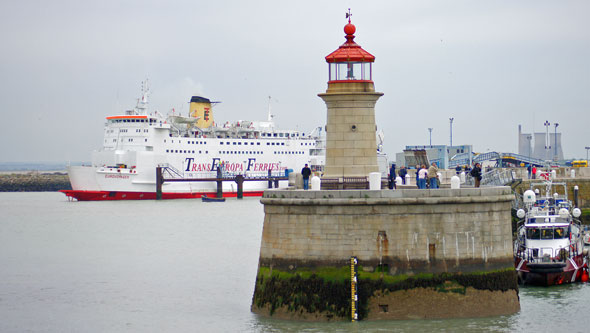
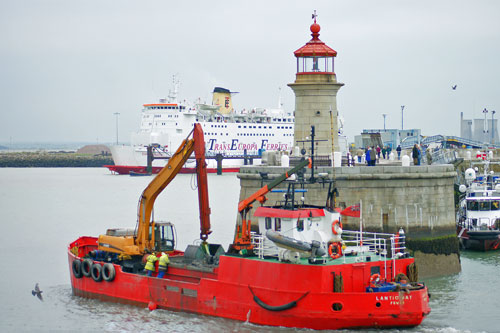
Images of Ramsgate lighthouse
Photos:- ©2013 Ian Boyle
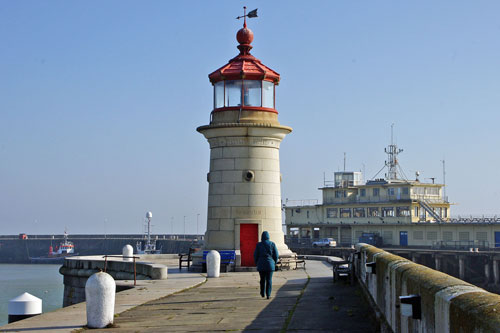
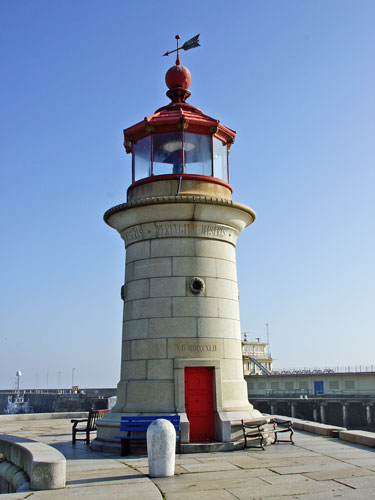
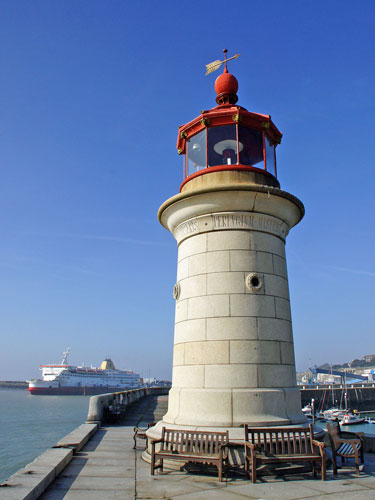
Ramsgate East Breakwater Light
Photo: © Ian Boyle, 10th May 2010
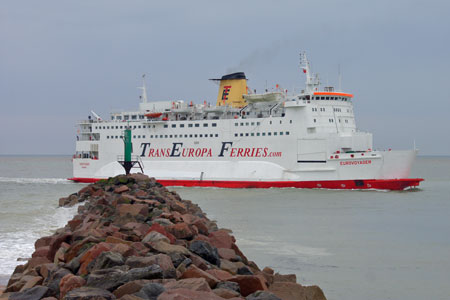
Ramsgate East Breakwater Light
Photo: © Ian Boyle, 26th September 2004
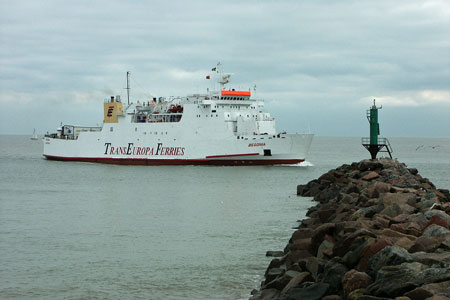
Two lighthouses were built at South Foreland in 1636.
Trinity House took over the lights in the 1830s and they replaced the high
light in 1843, followed by the low light in 1846. The low light was
discontinued in 1904 due to movements in the sands, and the high light was
decommissioned in 1988. It is now owned by the National Trust and it
is open for visitors. The low light has been described as derelict but
appears in a good cosmetic state in the images below.
Postcard of South Foreland Lighthouse
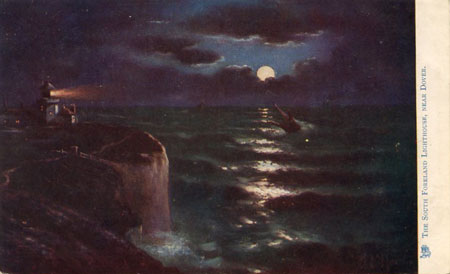
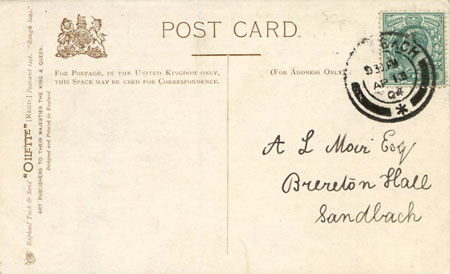
South Foreland High Lighthouse - note
the light aircraft!
Photo: © Ian Boyle, 12th November 2006
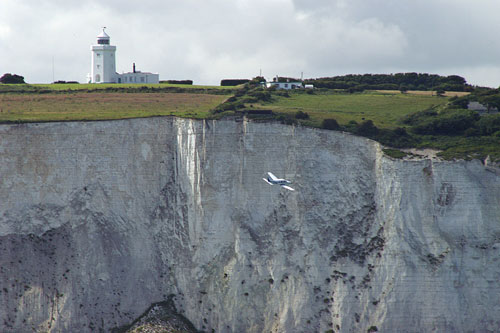
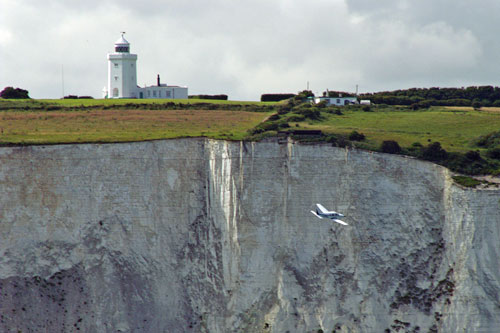

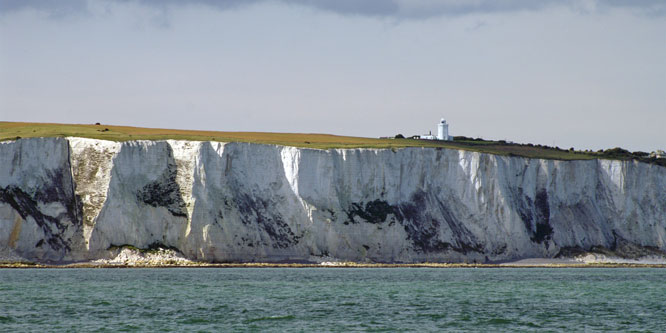
South Foreland High Lighthouse
Photo: © Ian Boyle, 12th November 2006
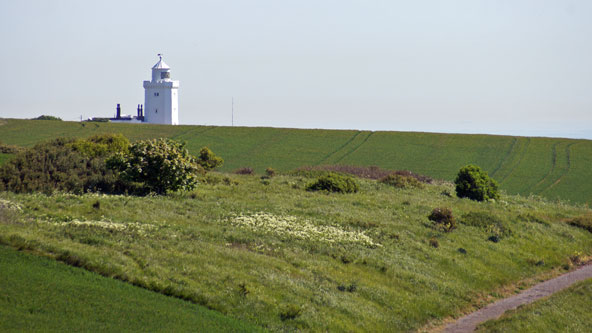
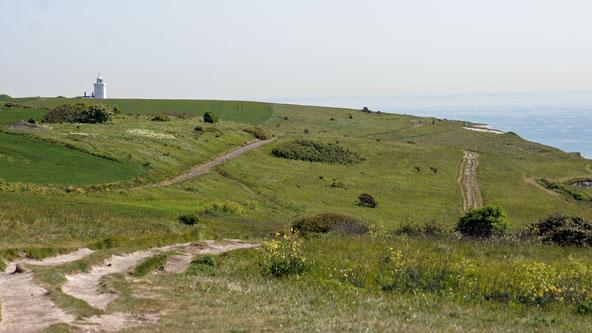
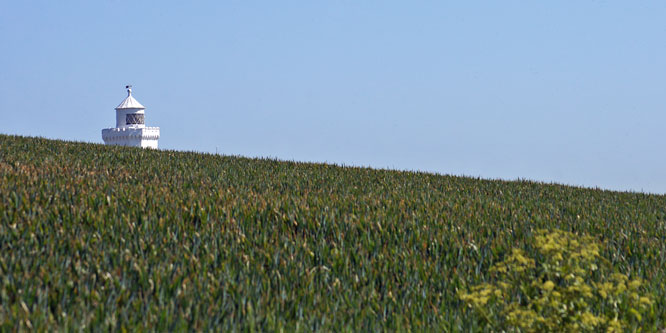
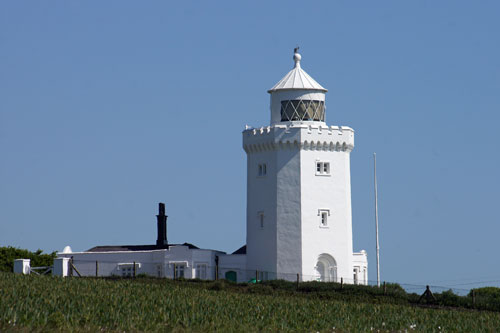
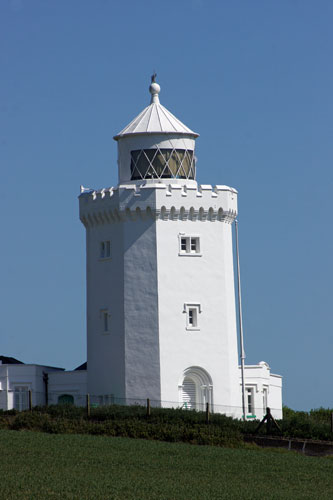
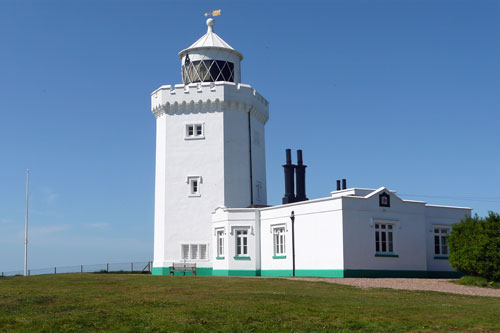
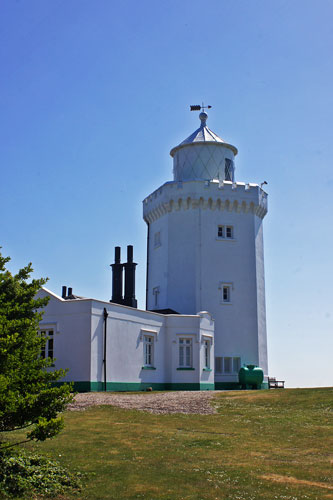
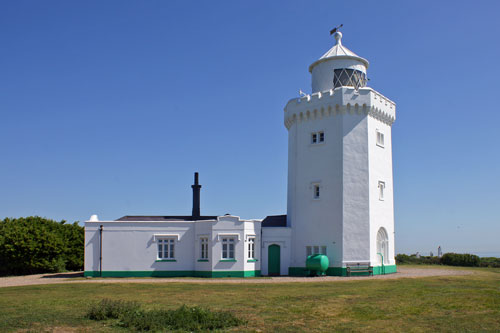

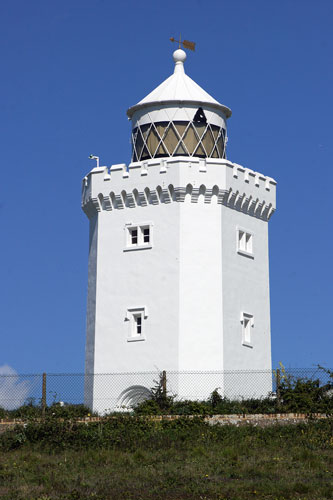
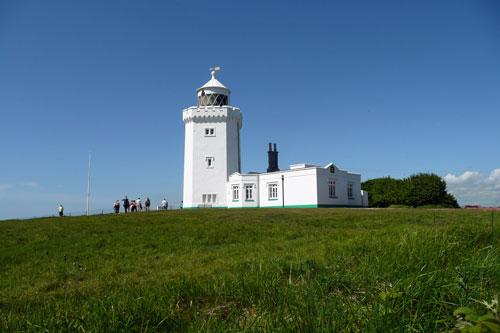
South Foreland Low Lighthouse
Photo: © Ian Boyle, 12th November 2006
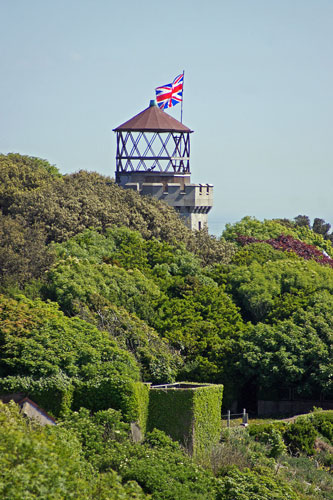

The Western Pharos at Dover, in
the grounds of the Dover Castle
Photo: © Ian Boyle, 29th January 2009

The Western Pharos at Dover, in
the grounds of the Dover Castle
Photo: © Ian Boyle, 29th January 2009
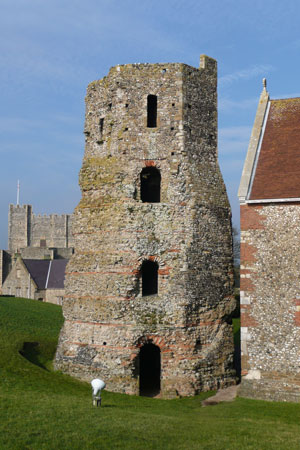
Dover Southern Breakwater -
Eastern Entrance
Photo: © Ian Boyle, 3rd February 2010
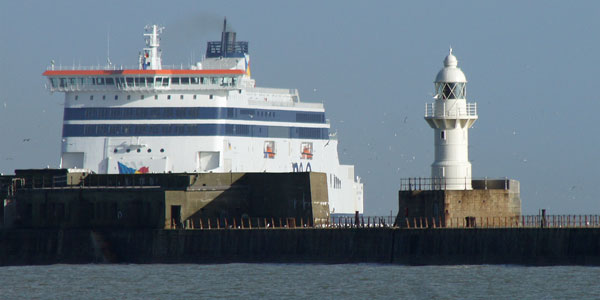
Dover Southern Breakwater -
Western Entrance, with Spirit of Free Enterprise leaving for Calais
Photo: © Ian Boyle, 1986
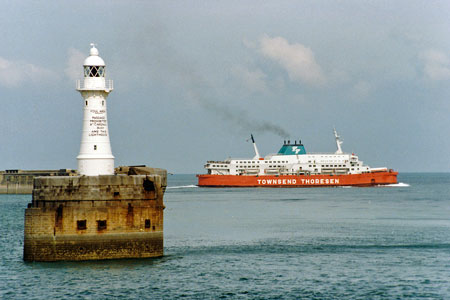
Dover Southern Breakwater -
Western Entrance
Photo: © Ian Boyle, 3rd February 2010
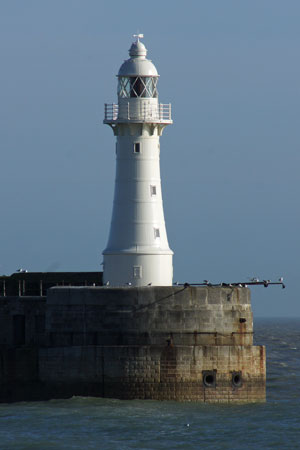
Dover Southern Breakwater -
Western Entrance
Photo: © Ian Boyle, 3rd February 2010
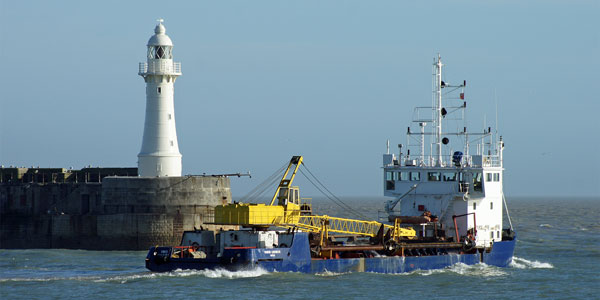
Dover Southern Breakwater -
Western Entrance
Photo: © Ian Boyle, 4th August 2007
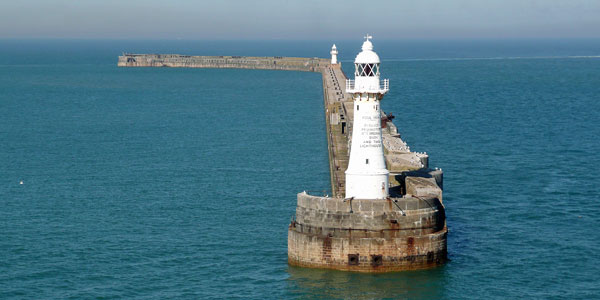
Dover Southern Breakwater -
Western Entrance
Photo: © Ian Boyle, 4th August 2007
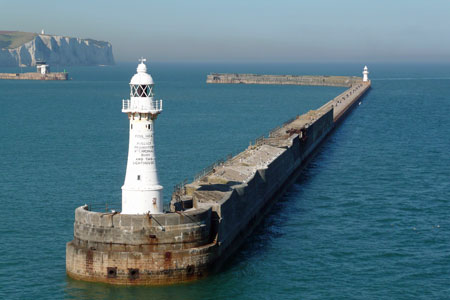
Dover Prince of Wales Pier
Photo: © Ian Boyle, 3rd February 2010
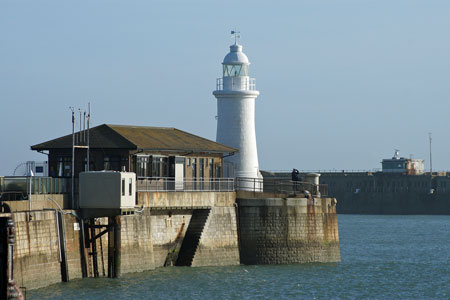
Dover Prince of Wales Pier
Photo: © Ian Boyle, 3rd February 2010
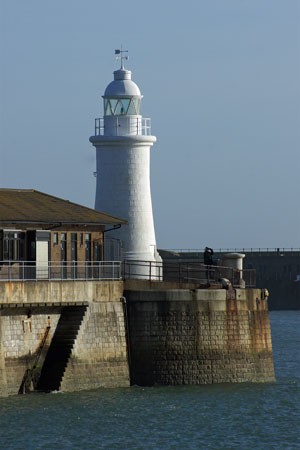
Dover Prince of Wales Pier
Photo: © Ian Boyle, 4th August 2007
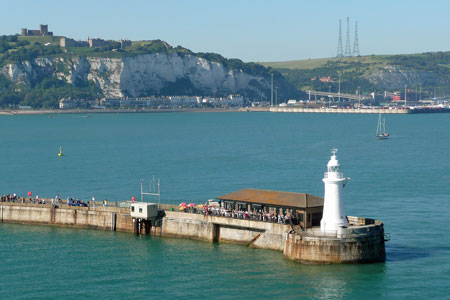
Dover Prince of Wales Pier
Photo: © Ian Boyle, 4th August 2007

Dover Admiralty Pier
Photo: © Ian Boyle, 3rd February 2010
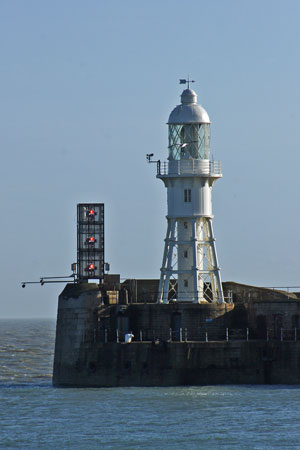
Pier and harbour works were built at Folkestone
between 1807-1820, but the harbour silted up and its removal was deemed too
expensive, The South Eastern Railway (SER) took over the harbour in 1842 and
commenced dredging to make Folkestone their principal port for the
continent. In 1848 they built the ornate wooden lighthouse, known as the
Horn Tower, shown in the first postcard below. The SER then built a new
breakwater in 1860 with a new lighthouse at the end. This lighthouse remains
in use and is accessible via the pier. The Horn Tower was decommissioned and
dismantled in 1941.
Postcard of Folkestone Pier Horn
Tower of 1848, with SER paddle steamer arriving
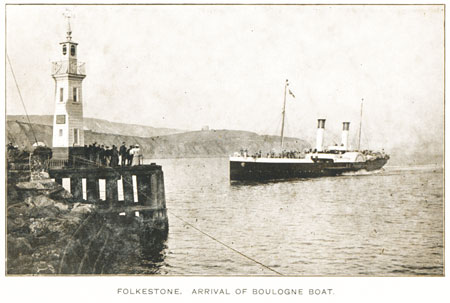
Folkestone Pier New Lighthouse
with the turbine Onward
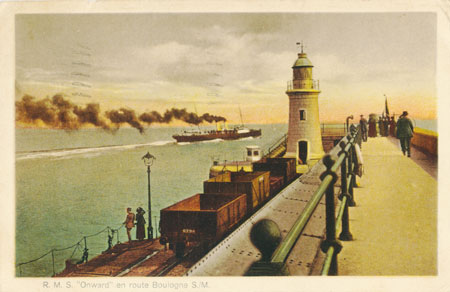
Folkestone Pier with New
Lighthouse and Sealink's Vortigern
Photo: ©1980 Ian Boyle
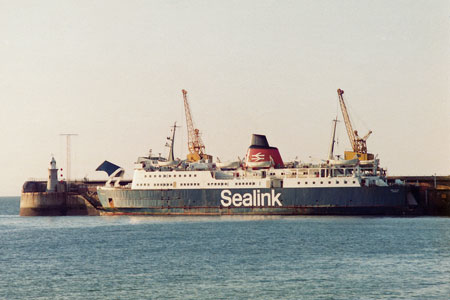
Folkestone Pier with New
Lighthouse
Photos: ©2011 Ian Boyle, 30th April 2011
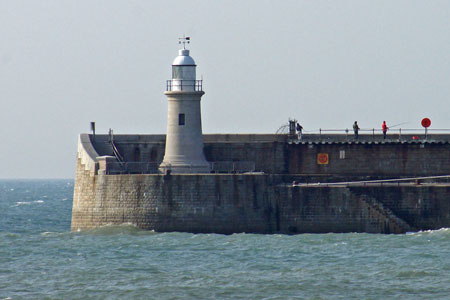
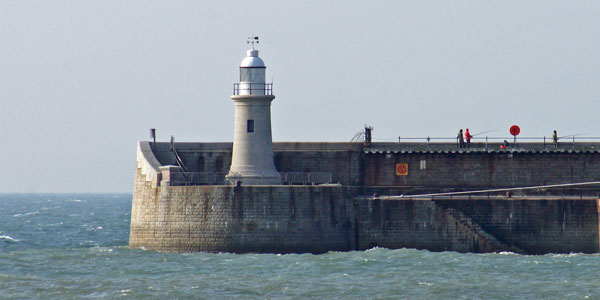
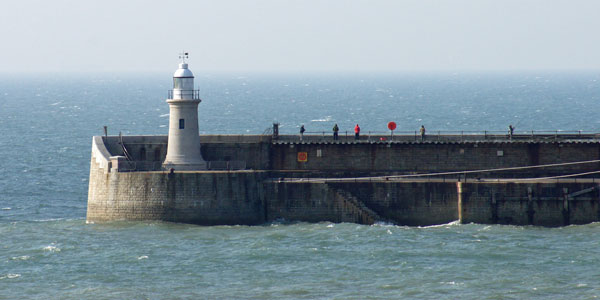

The first light on Dungeness Spit was completed in
1615. This was replaced in 1635 and again in 1792 as the shingle bank
expanded so that by the late nineteenth century it was 400 yards from the
shore. A moveable low light was installed near the end of the spit. In 1904
the high light was demolished and replaced by the Old Lighthouse still
standing. It is one of the tallest lights in Britain at 143ft. When the
nuclear power station was built, it obscured the light and so a new 131ft
concrete light was built in 1961.
Dungeness Old Lighthouse
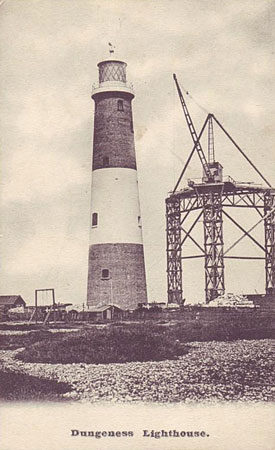
Dungeness Old Lighthouse
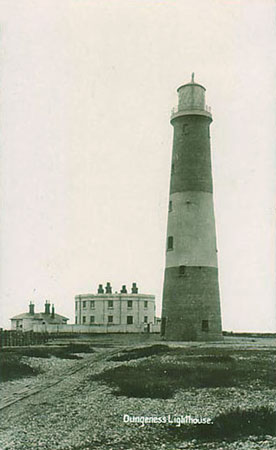
S&E Ltd 'Norman' postcard of Dungeness Old Lighthouse
with RH&DR train
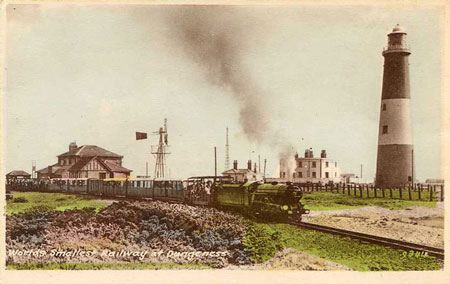
S&E Ltd 'Norman' postcard of Dungeness Old Lighthouse
with RH&DR train
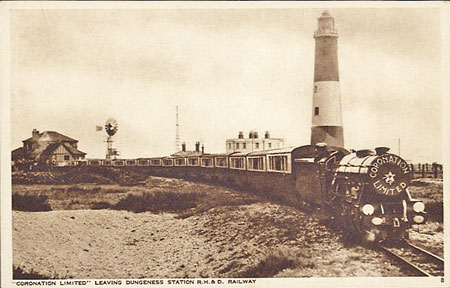
Valentine's postcard of Dungeness Old Lighthouse
with RH&DR train
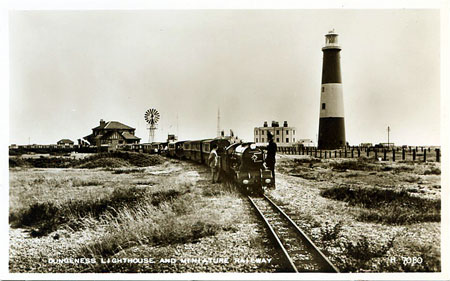
Salmon postcard of Dungeness Old Lighthouse
with RH&DR train
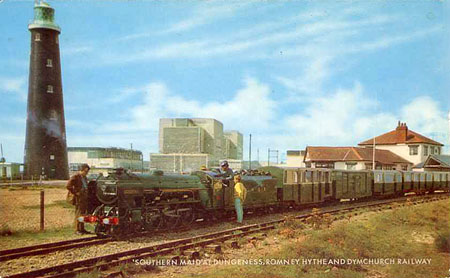
S&E Ltd 'Norman' postcard of Dungeness Old Lighthouse
with RH&DR train
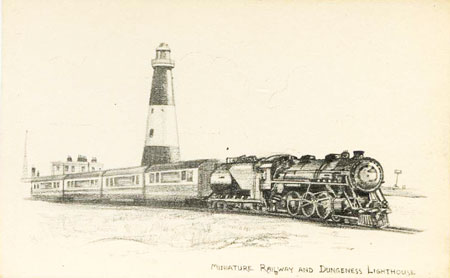
Dungeness Old Lighthouse
Photo: © Ian Boyle, 12th November 2006
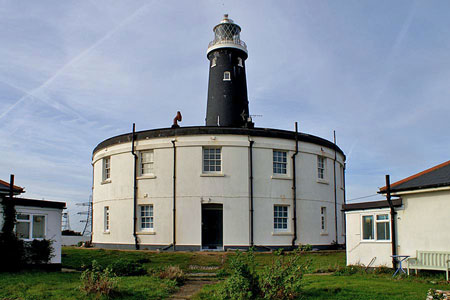
Dungeness Old Lighthouse
Photo: © Ian Boyle, 12th November 2006
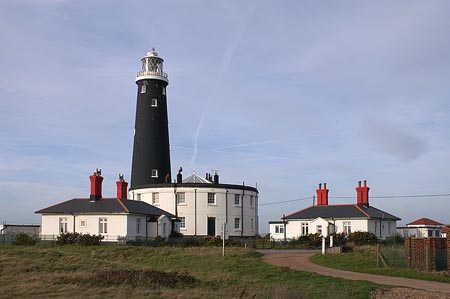
Dungeness Old Lighthouse
Photo: © Ian Boyle, 12th November 2006
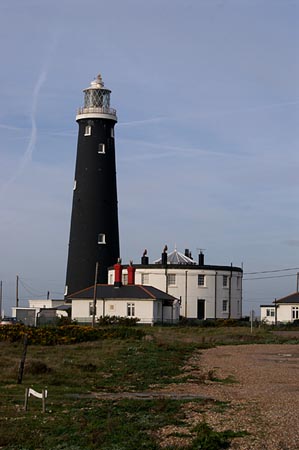
Dungeness Old Lighthouse
Photo: © Ian Boyle, 12th November 2006
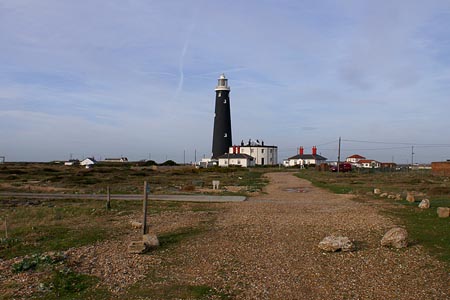
Dungeness Old Lighthouse seen
from MV Balmoral
Photo: © Ian Boyle, 10th July 2007
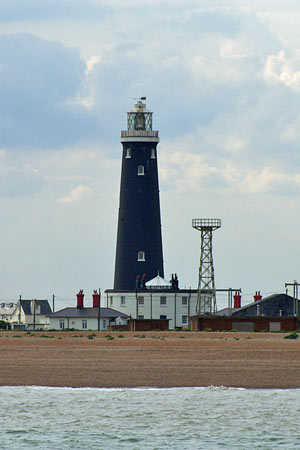
Dungeness Old Lighthouse seen
from MV Balmoral
Photo: © Ian Boyle, 10th July 2007
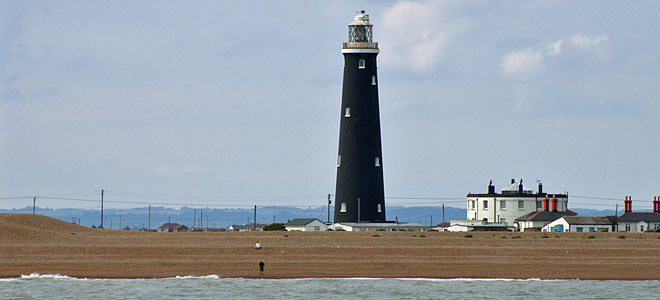
Dungeness New Lighthouse seen
from MV Balmoral
Photo: © Ian Boyle, 10th July 2007

Dungeness New Lighthouse
Photo: © Ian Boyle, 12th November 2006
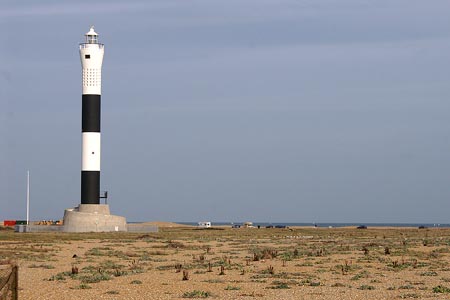
Dungeness New Lighthouse
Photo: © Ian Boyle, 12th November 2006
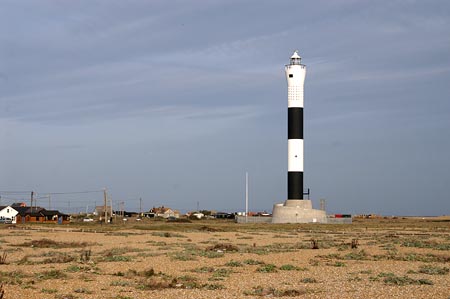
Dungeness New Lighthouse
Photo: © Ian Boyle, 12th November 2006
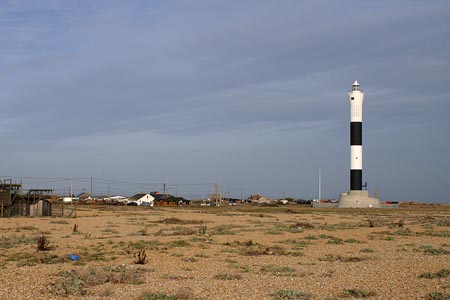
Dungeness New Lighthouse
Photo: © Ian Boyle, 12th November 2006
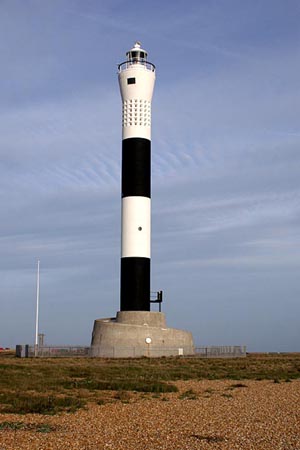
Dungeness New Lighthouse seen
from MV Balmoral
Photo: © Ian Boyle, 6th June 2006
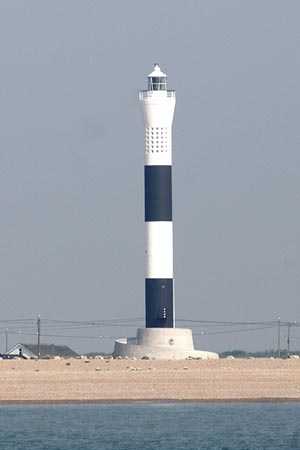
Dungeness Old & New Lighthouse
seen from MV Balmoral
Photo: © Ian Boyle, 6th June 2006
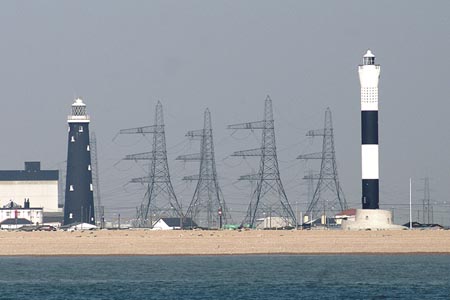
Dungeness New Lighthouse with
Samson of the Romney, Hythe & Dymchurch Railway
Photo: © Ian Boyle, 30th April 2011
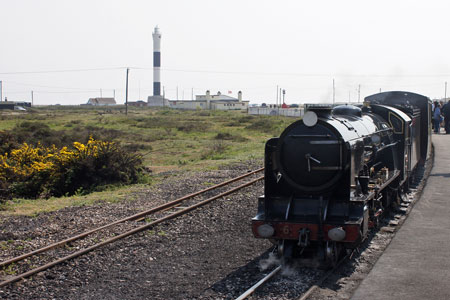
Dungeness Old Lighthouse with
Samson of the Romney, Hythe & Dymchurch Railway
Photo: © Ian Boyle, 30th April 2011
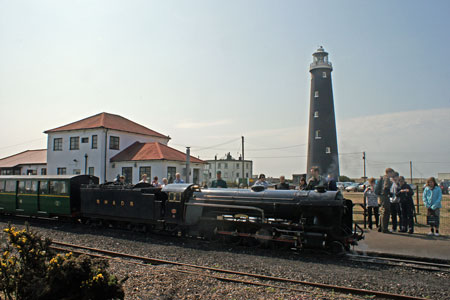
Dungeness Old Lighthouse with
Samson of the Romney, Hythe & Dymchurch Railway
Photo: © Ian Boyle, 30th April 2011
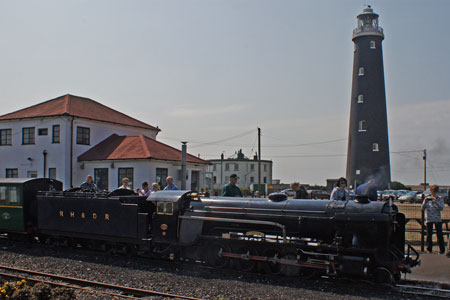
Dungeness Old Lighthouse
Photo: © Ian Boyle, 30th April 2011
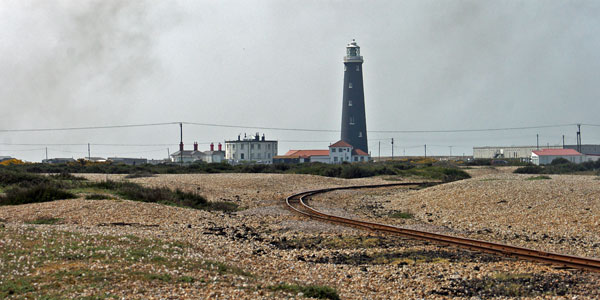
Dungeness Old Lighthouse
Photo: © Ian Boyle, 30th April 2011
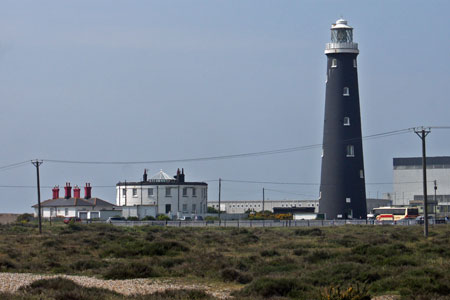
Dungeness Old Lighthouse
Photo: © Ian Boyle, 30th April 2011
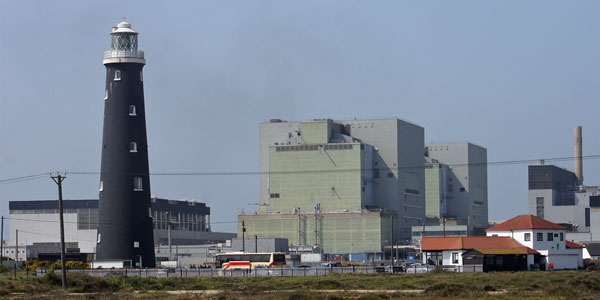
Dungeness Old Lighthouse
Photo: © Ian Boyle, 30th April 2011
